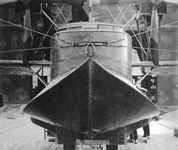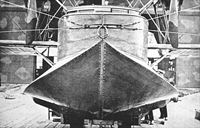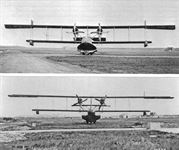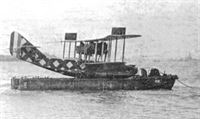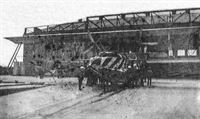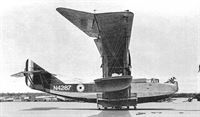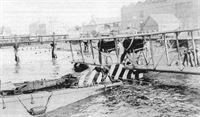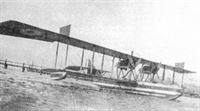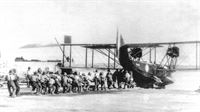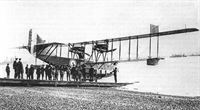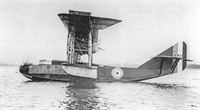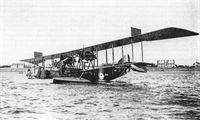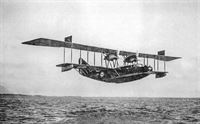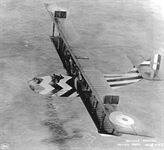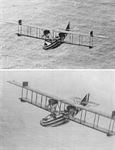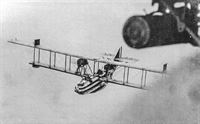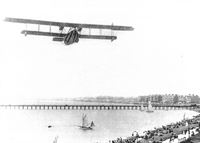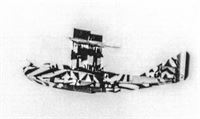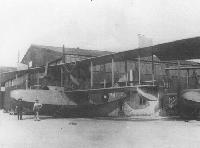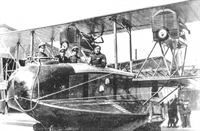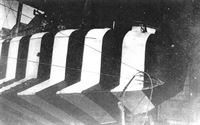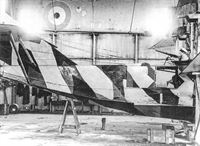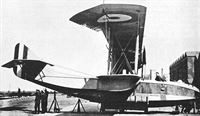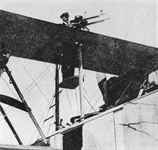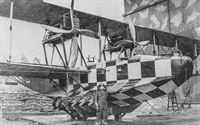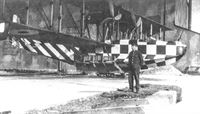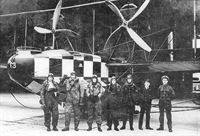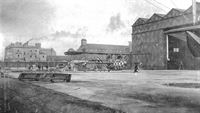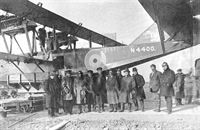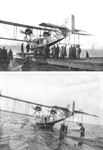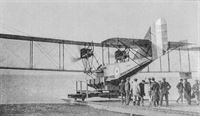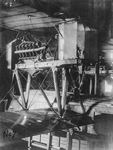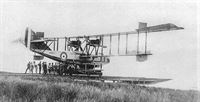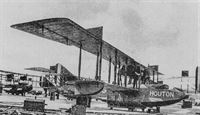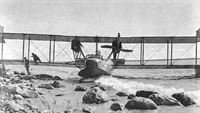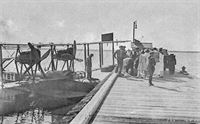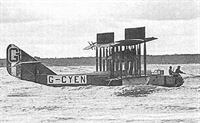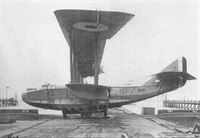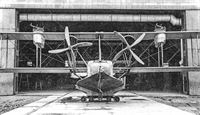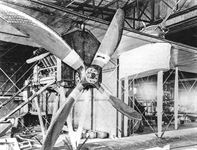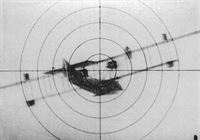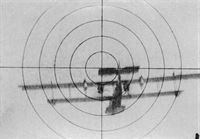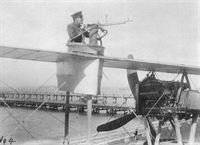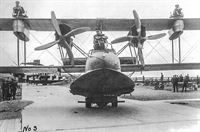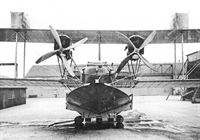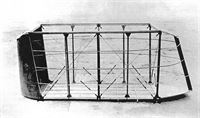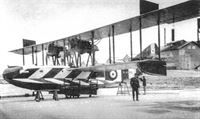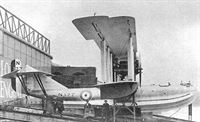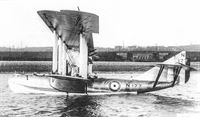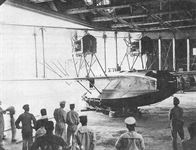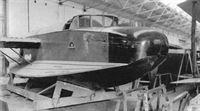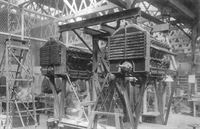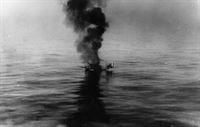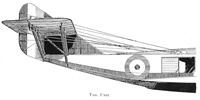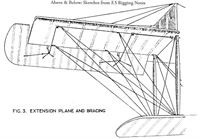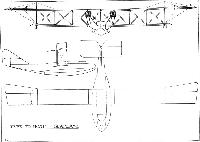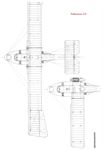В.Обухович, А.Никифоров Самолеты Первой Мировой войны
В 1913 г. американская компания "Кертисс" основала в Великобритании дочернюю фирму "Уайт энд Томпсон", которая занималась продвижением летающих лодок на английский рынок. Летчиком-испытателем фирмы стал англичанин Джон Порте, тесно сотрудничавший с Кертиссом в подготовке беспосадочного перелета через Атлантику на его летающей лодке, названной "Америка". Начавшаяся война помешала осуществлению этого проекта. Порте поступил на службу в морскую авиацию и был направлен в Америку для закупки летающих лодок Кертисс Н-4. После возвращения в 1915 г. в Англию он был назначен командиром авиационной базы ВМС Великобритании в Феликстоу. Большой опыт морского летчика позволил Порте взяться за разработку летающей лодки собственной конструкции, названной Феликстоу F.1. Впрочем, новым был лишь однореданный корпус лодки. Крыло и оперение Порте взял от гидросамолета Кертисс Н-4. Феликстоу F.1 был оснащен двумя двигателями Испано-Сюиза.
Документация на F.1 была передана компании "Кертисс", где проект был усовершенствован и запущен в серийное производство с двигателями Кертисс (160 л. с.) под обозначением Н-8 "Большая Америка". В 1916 г. 50 таких летающих лодок были закуплены Великобританией. Мощность двигателей была недостаточной, и Порте решил установить на Н-8 новые 12-цилиндровые V-образные двигатели жидкостного охлаждения Роллс-Ройс "Игл I" (250 л. с). Этот вариант получил наименование H-12. Однако лодка плохо показала себя в условиях Северного моря, и Порте спроектировал новый двухреданный корпус, а также модифицировал хвостовое оперение. Крылья и двигатели остались прежними, как у H-12. Летные характеристики лодки значительно выросли. Серийно выпускался вариант F.2A с двигателями Роллс-Ройс "Игл VIII" (355 л. с). Модификация Феликстоу F.2C имела корпус облегченной конструкции и двигатели Роллс-Ройс "Игл II" (275 л. с), которые впоследствии были заменены на Роллс-Ройс "Игл VI" (322 л. с). Эта летающая лодка имела отличные летные данные, но в серию она запущена не была.
Самолеты Феликстоу F.2А применялись для дальней разведки, противолодочного патрулирования и в качестве многоместного истребителя охраны побережья. 4 июля 1918 г. капитан Паттисон, пилотирующий F.2A, сумел сбить над Гельголандом германский морской дирижабль L 62.
Увеличенный вариант F.2 с двумя двигателями Санбим "Коссак" (330 л. с.) или Роллс-Ройс "Игл VIII" был облетан в феврале 1917 г. и получил обозначение Феликстоу F.3. Бомбовая нагрузка возросла вдвое. Конструкция летающей лодки получилась удачной, хотя скорость считалась недостаточной, поэтому самолет, в основном, применялся для противолодочного патрулирования. Самолеты F.3 производились также компаниями "Шорт" и "Феникс". До конца войны было изготовлено около 100 машин, которые использовались на Средиземном море. Впоследствии многие летающие лодки Феликстоу F.3 были переоборудованы в следующую (послевоенную) модификацию F.5, которая по конструкции была аналогична F.2.
Двигатель 2 х Роллс-Ройс "Игл VIII" (355 л. с.)
Размеры:
размах х длина х высота 29,15 х 14,1 х 5,33 м
Площадь крыльев 105,26 м2
Вес:
пустого 3424 кг
взлетный 4980 кг
Максимальная скорость 153 км/ч
Потолок 2900 м
Дальность 950 км
Продолжительность полета 6 ч
Вооружение:
стрелковое 4-7 х 7,7-мм пулеметов "Льюис"
бомбовое 2 х 104 кг
Экипаж 4 чел.
Показать полностью
G.Duval British Flying-Boats and Amphibians 1909-1952 (Putnam)
Porte/Felixstowe F.2 and F.2A (1917)
As a result of the shortcomings of the Curtiss H.4 regarding long-range patrol work, Porte requested Glenn Curtiss to develop a larger flying-boat with greater range and load-carrying capacity, and an order for fifty such machines was placed in 1915, the first being delivered in July 1916. This was the Curtiss H.8, or ‘Large America’, powered by two 160 h.p. Curtiss engines. These engines proved to be unsatisfactory, however, and Porte had them replaced by two 250 h.p. Rolls-Royce units, the modified machines being designated Curtiss H.12. They performed quite well, but suffered from weak, unseaworthy hulls, and poor fields of fire for the defensive armament. Encouraged by the excellent results obtained for the Porte 1 hull, Porte decided to redesign the hull of the H. 12, ably assisted by his Chief Technical Officer, Lieut, (later Major) J. D. Rennie. The new hull used the same construction method as the Porte 1 and measured 42 feet 2 inches from bow to stern, with two steps, and side fins 30 feet in length. Fitted with the mainplanes of an H.12, two 250 h.p. Rolls-Royce engines and a new tail unit, the machine, serialled No. 8650, was designated F.2 and proved vastly superior in performance to the standard H.12, taking off smoothly and easily at a loaded weight of 10,500 pounds. After some structural modifications were made in the light of operational experience, quantity production was authorised, the production version designated F.2A. Fitted with the more powerful Marks of the Rolls-Royce Eagle, the F.2A had a range and endurance more than adequate for defensive and offensive patrols, and a formidable armament consisting of two 230-pound bombs and up to five Lewis guns with excellent fields of fire. The fuel system, however, gave a lot of trouble, mainly due to its layout. A 409-gallon tank situated in the hull fed a 26-gallon gravity tank in the upper mainplane centre section by means of wind-driven pumps, the fuel then passing to the engines by gravity. Blocked pipes and filters, and fuel pump failures caused many forced alightings, and a contemporary report stated that ‘our real enemy is our own petrol pipes’. This situation led to the adoption of bizarre colour schemes for F.2A hulls, using red, white, and yellow paint, so that stricken machines could be readily spotted and towed home. Production F.2As began to appear late in 1917, a sub-contract having been arranged with Short Brothers, of Eastchurch. These machines had a two-stepped hull, only slightly differing from that of the F.2. In the bows, the front gunner’s cockpit was equipped with twin Lewis guns on a Scarff ring-mounting, while the rear gunner was positioned aft of the lower mainplane with similar armament. Some aircraft also had single guns, fired from side-hatches in the hull. The first and second pilots, the latter acting as front gunner, were partially enclosed in a glazed cabin, although this was often removed to improve visibility and performance. Engine control was simplified by the employment of an engineer-gunner, positioned in an internal compartment and controlling engine starting and inflight temperatures. The fourth crew member was usually a rigger-gunner. This crew arrangement tended to make the boats less dependent on their bases for servicing and minor repairs, and was standard in all large R.N.A.S. flying-boats. The F.2A power units were two Rolls-Royce Eagle VI Ils, developing 346 h.p. at 1,800 r.p.m. and driving four-bladed tractor propellers, the revolutions of which were reduced to 1,080 r.p.m. by epicyclic gearing. Some of the early F.2As had fabric decking to their hulls, but the ravages of wind and weather soon indicated its weakness and later machines had plywood decking. Production was greatly facilitated by the fact that the relatively simple hull construction did not call for highly skilled labour, and also by the availability of H.12 components, but demands for Rolls-Royce engines so far exceeded the supply that the total number of F.2As on charge never reached official requirements. To offset this situation several H.12s were rebuilt with Porte hulls and F.2A tail units, these modifications rendering them indistinguishable from F.2As.
Together, the F.2As and H.12s rendered great service in the critical year of 1917, when U-boat warfare was at its height. The first success came on 20 May, when the H.12 commanded by Fit. Sub-Lieut. Morrish destroyed submarine UC-36, and by the end of the year the flying-boats had sighted sixty-seven U-boats and had attacked forty-four. The Zeppelins, too, came in for attention, and on 14 May, 1917, L.22 fell to the guns of H.12 No. 8666, captained by Fit. Lieut. Galpin. In June, L.43 was destroyed by H.12 No. 8677, and a year later an F.2A from Killingholme, flown by Captains Pattinson and Munday, was responsible for the destruction of L.62 over the Heligoland minefields. All this activity took place in the face of strong German opposition, mainly from seaplanes under the command of the German Naval ‘ace’, Christiensen, and many combats took place, culminating in a pitched battle on 4 June, 1918. On that day, Capt. Robert Leckie led a force of four F.2As and a single H.12 on an offensive patrol towards the Haaks Light Vessel, three hours flying time from Felixstowe. After two-and-a-half hours, one of the F.2As was forced down by a broken petrol feed pipe, and its pilot, Capt. R. F. L. Dickey, had no choice but to taxi to the Dutch coast. On the way, five German seaplanes made a half-hearted attack upon the crippled machine, losing one of their number to its gunners, the rest breaking off the action, hotly pursued by the H.12, while the three F.2As formed a protective circle over Dickey’s machine. Soon afterwards, a formation of ten more German seaplanes arrived and Leckie charged them head-on, losing his wireless aerial on the upper wing of the enemy leader and splitting up the formation. The battle which followed lasted forty minutes, during which time the flying-boats shot down two Germans and probably destroyed four more without loss to themselves, although one F.2A went down on the Zuider Zee with a broken petrol pipe during the action. This was repaired by the engineer, however, and the machine rejoined the others. On the way back to Great Yarmouth, Capt. J. Hodson’s aircraft had an engine failure, flight being maintained on half-power while repairs were effected. Two flying-boats had been lost, for the H.12 force-landed in Dutch waters also, and both crews were interned. In 1918 the range of the flying-boats was extended by the use of special lighters designed by Porte, the machines being floated on to the fighters and towed by destroyers to a launching point off the German coast, returning after reconnaissance flights to be towed home. This system had its limitations, but several successful operations were completed. Another method of extending range was the carriage of extra fuel in cans, and by this means flights of over nine hours’ duration were made, pilot fatigue being minimised by the fitting of dual control to the F.2A.
Two illustrations are on record to prove the strength of the F.2A; in one, a machine was actually looped over Killingholme by an aggrieved American trainee, and in the other a single-engined approach aimed at Leeds Reservoir was misjudged and terminated in a ploughed field, the only damage incurred being strained bracing wires.
SPECIFICATION
Power Plant:
F.2 and H.12 - Two 250 h.p. Rolls-Royce Eagle I
F.2A - Two 345 h.p. Rolls-Royce Eagle VIII
Span: F.2, F.2A, and H.12 - 95 feet 7 1/2 inches
Length:
H.12 - 46 feet 6 inches
F.2 and F.2A - 46 feet 3 inches
Weight Loaded:
H.12 - 10,650 pounds
F.2 - 10,000 pounds
F.2A - 10,978 pounds
Total Area: F.2, F.2A, and H.12 -1,133 square feet
Max. Speed:
H.12 - 85 m.p.h.
F.2 - 95 m.p.h.
F.2A - 95-5 m.p.h.
Endurance: F.2, F.2A, and H.12 - 6 hours (normal)
Armament:
H.12 - Up to four Lewis guns on flexible mountings in bow and pilot’s cockpit. Four 100-pound or two 230-pound bombs
F.2 - Experimental gun installations for F.2A, max. bomb load of 460 pounds
F.2A - Four to seven Lewis guns on flexible mountings, two 230-pound bombs�
Porte/Felixstowe F.2C (1917)
An experimental version of the F.2A, the F.2C did not pass beyond the prototype stage. It was fitted with a modified hull of lighter construction, having alterations to the front gun position, an open cockpit for the pilots, and no hull side hatches. The F.2C power units were initially 275 h.p. Rolls-Royce Eagle Ils, later replaced by the 322 h.p. Eagle VI. Official trials took place on 23 June, 1917, the machine showing a slightly better performance than the F.2A, but the margin was too small to justify interference with the F.2A production programme. However, the F.2C, serialled N65, saw active service with the R.N.A.S. at Felixstowe and on 24 July, 1917, flown by Wg. Cmdr. Porte, released two of the five 230-pound bombs which sank submarine UC-1. Some time later the machine was fitted with experimental pneumatic bomb-release gear which chose to be temperamental at the worst possible moment resulting in a surfaced U-boat escaping unscathed.
SPECIFICATION
Power Plant: Two 275 h.p. Rolls-Royce Eagle II or 322 h.p. Eagle VI
Span: 95 feet
Length: 46 feet
Weight Loaded: 10,240 pounds
Total Area: 1,136 square feet
Max. Speed: 98-5 m.p.h.
Endurance: 6-5 hours
Armament: Two Lewis guns, two 230-pound bombs
Porte/Felixstowe F.5 (1918)
Intended as an improvement upon the F.3, the F.5 appeared in early 1918. Externally similar to its predecessors, and employing the standard Porte hull construction, it embodied a number of refinements developed as a result of experience with the previous designs. The top decking of the hull was deeper than before, and the pilots were seated in an open cockpit, while the gun positions were of the same arrangement as the F.3. Four 230-pound bombs could be carried in the standard underwing racks. The wing structure was entirely new, with a span greater than the F.3 and a modified section, also constant-chord ailerons. A broad-chord tailplane projected ahead of the fin leading edge, the rudder, and the ailerons, being horn-balanced. Serialled N90, the prototype was powered by two 350 h.p. Rolls-Royce Eagle VIIIs driving four-bladed tractor propellers, and on its official trials it displayed a much better performance than the F.3, even under conditions of overload. Unfortunately, the prototype F.5 fell foul of economics, for the large F.3 construction programme did not readily permit the introduction of a new type. A compromise was reached with the extensive modification of the F.5 to incorporate as many F.3 components as possible, resulting in a machine not wholly satisfactory, but nevertheless put into production. The hull of the modified machine was similar to that of N90, but its overall covering of plywood, with only the top decking of fabric, added considerably to the weight, which, in the completed aircraft, exceeded that of N90 by more than 1,000 pounds. The wing structure was that of the F.3, modified to take constant-chord ailerons, and the tail unit was identical to that of the prototype, although later F.5s had horn-balanced elevators. The slightly greater wing span of the F.5 as compared to the F.3 was accounted for by the ailerons, which extended beyond the wing-tips. Official test figures show that the performance of the production F.5 was inferior to that of the F.3, and in some instances this was further impaired by the fitting of lower powered engines, the 325 h.p. Rolls-Royce Eagle VII.
Too late for operational service, the type was adopted as the R.A.F.’s standard post-war flying-boat and remained in service until replacement by Southamptons in 1925. In the summer of 1919, an early production F.5, N4044, toured Scandinavia to demonstrate the capabilities of flying-boats, covering 2,450 miles in 27 days and returning to Felixstowe fully serviceable. Another equally successful tour took place in 1923, when two F.5s commanded by Air Commodore Bigsworth completed a cruise to Gibraltar, Malta, Bizerta, and Oran without mishap.
Before the Armistice, F.5 production had started in Canada at the factory of Canadian Aeroplanes Ltd to the order of the United States Air Board. These machines were fitted with the Liberty 12 engine of 400 h.p. and equipped the U.S. Naval Air Service in 1918. A series of structurally modified F.5s was also built by the U.S. Naval Aircraft Factory at Philadelphia; these too had the Liberty engine and were designated F.5L. The F.5L could carry 1,000 pounds of bombs and up to eleven machine-guns, and some mounted a Davis quick-firing gun in the bows. These machines gave years of service to the U.S. Navy,both in the Atlantic and the Pacific Fleets, later versions having a greatly enlarged fin and a horn-balanced rudder. Also in America, two converted F.5Ls formed the equipment of one of the first airlines to operate flying-boats, Aeromarine West Indies Airways, Inc., in 1920. In 1921, the Japanese company, Aichi of Nagoya, obtained a licence to build F.5s and produced fifteen machines which served with the Imperial Japanese Naval Air Service and made several notable long-distance flights, recording durations of over nine hours in some cases. In this country, the F.5 was used for a number of experiments, among which were the trial of auxiliary aerofoil aileron balances on N4838, and the fitting of a special hollow-bottom Saunders hull to N178. In 1924, Short Brothers produced an F.5, N177, with an all-metal hull, the first military flying-boat in the world to be so fitted. The F.5 formed the equipment of eight R.A.F. squadrons, a ninth, No. 230, being renumbered No. 480 Flight at the end of 1922 and forming the training establishment for flying-boats at Calshot.�
SPECIFICATION
Power Plant:
Prototype - Two 350 h.p. Rolls-Royce Eagle VIII
Production - Two 350 h.p. Rolls-Royce Eagle VIII or two 325 h.p. Rolls-Royce Eagle VII
Canadian F.5s and American F.5Ls - Two 400 h.p. Liberty 12
Span: 103 feet 8 inches
F.5L-103 feet 9 inches
Length : 49 feet 3 inches
Prototype - 49 feet 6 inches
Weight Loaded: 12,682 pounds
Prototype - 12,268 pounds
F.5L - 13,000 pounds
Total Area: 1,409 square feet
F.5L - 1,397 square feet
Max. Speed:
Prototype - 102 m.p.h.
Production - 88 m.p.h.
F.5L - 87 m.p.h.
Endurance: 7 hours (normal)
F.5L - 7-9 hours
Armament:
Four Lewis guns, four 230-pound bombs
Canadian machines could have up to eight Lewis guns
F.5L - maximum armament of one Davis gun, eleven Lewis guns. Normal armament was one Davis gun, four Lewis guns, and four 230-pound bombs or two 500-pound bombs�
Показать полностью
J.Bruce British Aeroplanes 1914-1918 (Putnam)
Felixstowe F.2A and F.2C
AFTER the success which had been achieved with the F.1, Squadron Commander Porte extended his A experiments to larger hulls. He began work with No. 8650, the first Curtiss H.12 flying boat to be delivered to the R.N.A.S.
The H.12 was generally similar in design to the H.4, but was considerably larger. On its appearance in service it was named the Large America, whereafter the H.4 was known as the Small America. As delivered, the H.12 had two 160 h.p. Curtiss engines, but when Porte began his experiments with No. 8650, these proved to be insufficiently powerful to get the boat off the water at a weight of 8,700 lb. The Curtiss engines were replaced by two 250 h.p. Rolls-Royce engines. Take-off was then accomplished, but with difficulty, owing to lack of buoyancy forward. The hull of the H.12 was weak structurally, yet these Large Americas did some excellent work when powered by two Rolls-Royce Eagle engines of later marks.
It was obvious that the F.1 hull was superior to that of the Curtiss H.12, so it was decided to build a hull similar to the Porte I but large enough to take the wings of the Large America. The new hull was known as the Porte II, and the aircraft to which it was fitted was designated F.2. It was the prototype of the line of successful F-boats, which gave such distinguished service up to and beyond the Armistice.
The F.2’s hull was almost identical to that of the F.1 in outline but was larger: it was 42 feet 2 inches long, and its maximum beam was 10 feet. It had only two steps, and these were applied outside the skin of the hull, as had been done on the F.1. The forward step was directly under the rear spar of the wings, and the rear step was 6 feet 5 inches farther aft. Structurally the hull was basically a cross-braced box girder, as opposed to the original Curtiss boat-built hull. Forward of the rear spar of the centre-section the sides of the hull were braced as N-girders; elsewhere the cross-bracing was by means of wires or tie-rods. The spars of the lower centre-section were integral parts of the hull box girder. The bottom longerons were spaced by solid mahogany members known as floors: these floors were inverted triangles whose downwards-pointing apices formed the ridge of the keel. Athwartships they were unbroken, but for two- thirds of their depth they were notched out to fit over the solid keelson, which was correspondingly notched out for one-third of its depth and ran from bows to sternpost as a continuous structural member.
As on the F.1, hull, the side fins were built on to the outside of the basic hull structure. To give adequate support to the planking between floors, intermediate timbers of rock elm ran from chine to chine. The double-diagonal planking consisted of an inner skin of 1/8-inch cedar and an outer of 3/16-inch mahogany separated by a layer of varnished fabric. This planking was applied to the hull bottom, whilst the fin tops and the hull sides were planked with three-ply; abaft the rear spar the hull sides were fabric-covered and had a solid mahogany washboard along the lower longerons. The top of the hull was also fabric-covered, with the exception of the portion in front of the cockpit, which was planked with plywood. A semi-enclosed cabin was provided for the crew. The shape of the hull was such that the tail was carried high: this served not only to keep the tailplane out of spray when taxying, but also to give the waist gunners a good field of fire towards the rear.
The wings were similar to those of the Curtiss H.12. The upper mainplanes had long extensions, the landing wires for which ran from rectangular pylons above the outermost interplane struts: these pylons were faired over with fabric, but the resulting vertical surfaces had no designed aerodynamic function. There were three bays of struts outboard of the engines.
The Porte II hull proved to be an excellent design, and the F.2 was strong and seaworthy. One of the great advantages of the Porte design of hull was its structural simplicity, which enabled it to be made by firms which had no experience of boat-building. The type was placed in production with several contractors in 1917, but delays occurred: an official decision to change from the original 23-inch gun-ring to one of 20-inch diameter necessitated structural modifications and held up. production.
The production machines had two 360 h.p. Rolls-Royce Eagle VIII engines, and embodied other minor modifications. They were designated F.2A. Deliveries began to be made at the end of 1917, and from early 1918 until the Armistice the type was in use at almost every flying-boat station of the R.N.A.S. This widespread use gave some trouble with the early F.2A hulls, for the machine had been designed to operate from sheltered harbours, and exposure to unfavourable sea conditions led to deterioration of the hull. The original 5-inch planks on the hull bottom warped, the plywood on the fin tops and sides opened up, and the fabric rotted. Narrower planks were therefore fitted, double-diagonal planking of mahogany and cedar was applied to the fin tops, and the sides were either given single planking with fabric covering or were completely planked with Consuta, the special material invented by S. E. Saunders, Ltd. It consisted of plywood sewn with copper into large sheets. Other structural modifications had to be made to meet the rigours of operational service.
The estimated life of the F.2A under mooring conditions was six to eight months, but where hangar and slipway facilities were available the boats were taken ashore on wheeled trolleys specially made to conform to the shape of the hull bottom. Manhandling these relatively fragile wooden hulls could be a tricky business, and the beaching crew had to be both numerous and skilful. A vivid account of a launching, take-off, flight, and landing and beaching of an F.2A is to be found in pages 352-357 of The Story of a North Sea Air Station, by C. F. Snowden Gamble.
The flying boats of Felixstowe air station are probably best remembered for their connexion with the famous “Spider Web” patrol. This patrol was flown as an octagonal figure centred on the North Hinder Light Vessel. Sixty nautical miles across, it enabled some 4,000 square miles of sea to be systematically searched: this area lay across the most possible tracks of enemy submarines. The five flying boats which began to operate the Spider Web patrol on April 13th, 1917, made twenty-seven patrols before the month was out, sighted eight U-boats and bombed three of them, and had one engagement with enemy destroyers.
It was into action of this tradition that the F-boats came. Unfortunately, the shortage of Rolls-Royce engines severely hampered the production of the big flying boats. In May, 1917, when the requirements of aircraft for 1918 were under consideration, it was estimated that 180 flying boats of the Large America type would be needed. The Government’s decision to double the size of the British air services, taken in July, 1917, increased that number to 426. In view of the fact that the average life of a flying boat was six months, the total requirements for the full year of 1918 amounted to 852 flying boats. This figure was impossible of achievement, but the net requirements were reduced to 234 upon the U.S. Navy Department’s agreement to equip five seaplane stations and upon the decision to build at Malta the sixty boats required for the Mediterranean area.
By March, 1918, 161 F.2As had been ordered, but only ten were in service. The required total of 234 was to consist of both F.2As and the later F.3s, but it was never realised. A review of the production of Rolls-Royce engines showed that sufficient Eagles would be available to equip only 170 Large America boats by the end of May, 1918. Even that estimate proved to be over-optimistic, for only 104 F-boats had been delivered by that date.
All the big twin-engined Porte-designed flying boats were known as Large Americas, and it is difficult to distinguish one type from another or from the original Curtiss H.12 in the official history. The F.2A was the best-known boat of the series, partly because it was a better machine than the F.3 and partly because the F.5 arrived too late to see service on a large scale.
The R.N.A.S. air station at Great Yarmouth received the first of its F.2As early in February, 1918, but trouble was experienced with the fuel system. The main fuel tanks were in the hull, and petrol was pumped to a gravity tank in the centre-section by means of wind-driven pumps; the carburettors were fed from the gravity tank. The total length of piping in the system was therefore considerable, and most of the faults occurred in the fuel pipes. On February 5th, 1918, the first patrol to be attempted by a Great Yarmouth F.2A was balked by a partial choke in a petrol pipe, and eleven days later the same machine, N.4511, was forced down one hour out from base with the gravity tank filter clogged. The crew were picked up by H.M.S. Glowworm, and owed their rescue to a home-made precursor of the dinghy radio developed in World War II. Leading Mechanic Walker had been experimenting at Yarmouth with a 5-foot linen box kite carrying an aerial, and on this occasion he had his apparatus with him on board N.4511. From its signals the position of the flying boat was fixed, and H.M.S. Glowworm found it only eight miles down wind from the position she was given.
The F-boats from Yarmouth and Felixstowe had many brushes with the Brandenburg W.12 and W.29 seaplane fighters from the enemy seaplane stations at Borkum, Norderney and Zeebrugge. The boats usually gave as good as they got, for their heavy defensive armament and the determination of their crews made up for their lack of speed and manoeuvrability.
On June 4th, 1918, five flying boats led by Captain R. Leckie set out for the Haaks Light Vessel with the one intention of seeking out and fighting enemy seaplanes. The force consisted of four F.2As and one Curtiss H.12: the F.2As were N.4295 and N.4298 from Great Yarmouth, and N.4302 and N.4533 from Felixstowe; whilst the H.12 was 8689 from Felixstowe. But even before the enemy were sighted the petrol feed pipe to one of the engines of N.4533 broke, and the F.2A was forced down. Its pilot (Captain Dickey) could do no more than taxi to Holland, where he beached and burned the machine. The H.12 had set off in hot pursuit of some German machines which had attacked and were intent on harassing the limping N.4533, and the three remaining F.2As were later engaged by a mixed force of fourteen enemy seaplanes. The F.2As fought an action which must rank as a veritable Jutland of the skies, and Leckie led the little force with magnificent audacity. N.4302 was compelled to go down with a broken petrol pipe, and Captain Hodson flew N.4289 on one engine whilst the other was repaired during the combat. The engineer of N.4302, Private Reid, made a temporary repair which enabled the boat to return to Great Yarmouth, despite a damaged wing-tip float.
At 7.10 p.m. the three F.2As alighted in Great Yarmouth Roads after being airborne just over six hours and fighting one of the greatest air battles of the war, for the enemy lost six seaplanes. But Leckie’s report included the acrid comment: “It is again pointed out that these operations were robbed of complete success entirely through faulty petrol pipes.... It is obvious that our greatest foes are not the enemy, but our own petrol pipes.”
This action was largely responsible for the general adoption of the gaudy “dazzle-painting” of many F-boats. The F.2A flown by Captain Hodson, N.4289, “was terrible in appearance, painted post-box red, with yellow lightning marks running diagonally across her ... he fondly hoped that this would put the wind up the Hun.” Whether it did that or not is not known, but it left Hodson’s comrades in no doubt about his aircraft’s identity. The first object of the dazzle-painting was to identify the pilot of any particular flying boat, so, at Great Yarmouth, the choice of scheme was left to individual pilots. This produced some bizarre combinations of checks, stripes and zig-zags in bright colours. Felixstowe had a more or less standard (but no less striking) colour scheme for its boats.
One of the Felixstowe F.2As was experimentally fitted with two “howdah” gun positions on the upper wing. Each contained a gunner and twin Lewis guns on a Scarff ring. The bow gunner also had twin Lewis guns, and it seems probable that the machine was intended to act as an escort fighter for the patrolling F.2As. The experiment was not a success, however, and the idea was abandoned.
On May 10th, 1918, an F.2A from Killingholme, flown by Captains T. C. Pattinson and A. H. Munday, engaged the Zeppelin L.62 at 8,000 feet over the Heligoland minefields. Captain Munday opened fire from the bow cockpit and Sergeant H. R. Stubbington, the engineer, also brought his Lewis gun to bear on the target. Many hits appeared to be scored, but the flying boat broke an oil feed pipe and had to alight on the sea. The Zeppelin made off due east, losing height and emitting smoke, and soon afterwards blew up and fell in flames.
A most ambitious scheme in which F.2A flying boats were concerned was the use of lighters, towed by destroyers, as a means of increasing the radius of action of the flying boats. The idea had first been proposed by Squadron Commander Porte in September, 1916. His original design was for a channel-shaped lighter which could be submerged by the flooding of tanks; after the flying boat had been floated into position, the water was blown out of the tanks by compressed air. This raised the flying boat clear of the water, and the lighter was free for towing.
Orders for four lighters were placed in January, 1917, and the first was successfully tested in the following June. As actually built, the lighter was made to submerge only at the stern and the flying boat was warped aboard. Towing trials promised well, and in September, 1917, a lighter with a flying boat aboard was towed at speeds up to 32 knots. Twenty-five lighters were ordered immediately, a number which was subsequently increased to fifty. The first was delivered in May, 1918, and fifty-one had been delivered by the time of the Armistice.
One of the chief objects of the use of lighter-borne flying boats was to carry out bombing attacks on the German naval bases in the North Sea, but their first use was to provide advanced take-off facilities for distant reconnaissances in the Heligoland Bight. The first operation of this kind took place on March 19th, 1918, apparently using three of the prototype lighters. At 5.30 a.m. three destroyers towed flying boats to a point off the German coast, and the three boats were airborne by 7 a.m. During their patrol they shot down one of two enemy seaplanes which attacked them, and flew back to their base direct. Next day the operation was successfully repeated, and the towed flying boats were used on several later occasions in 1918. The original intention of using the lighter-borne flying boats to bomb enemy naval bases was abandoned in July, 1918, by which time sufficient progress had been made with long-range bomber landplanes to bring the targets within their radius of action.
The F.2A remained in service right up to the time of the Armistice. Because its performance was better than that of the F.3 it was chiefly used from stations which covered the sea areas where fighting, anti-Zeppelin work and reconnaissance predominated. The F.3 was used at stations responsible for antisubmarine patrols, for which duty its longer range made it more suitable.
Many modifications were made to production F.2As: some were incorporated on the production lines; others were made locally at seaplane stations to meet the personal tastes of crews. One of the most noticeable changes Was the absence of the cabin top over the pilots’ cockpits on later F.2As: its removal improved their view considerably, particularly towards the rear, and added a few knots to the speed. Such F.2As began to appear about September, 1918. They also had the sides of the hull planked overall with mahogany or, in the case of the Saunders-built machines, Consuta.
A further significant modification, incorporated at this time, was the fitting of constant-chord horn-balanced ailerons similar to those of the F.5. This helped to relieve some of the considerable physical strain imposed upon the pilot; protracted patrols could be exhausting in a heavy aircraft which had no balanced controls of any kind. Several pilots went so far as to fit modified flight controls of their own design.
It is doubtful whether an F.2B variant was ever built, but the designation has been applied to the open-cockpit version of the F.2A. A modified type known as the F.2C was, however, built and flown. It had a lightened hull with modified steps and new contours for the forebody. The bow gunner’s cockpit was farther back from the bows than on the F.2A, and the cockpit for the pilots was open. A deep top-decking was fitted to the hull, and there were no waist hatches behind the wings.
Although the F.2C did not go into production, it was used operationally by the War Flight at Felixstowe seaplane station. On July 24th, 1917, Felixstowe sent out a patrol of five flying boats, the greatest number despatched together up to that time. The patrol was led by Wing-Commander Porte himself in the F.2C. Near the North Hinder Light Vessel, the periscope of a U-boat was sighted. Three of the flying boats dropped a total of five 230-lb bombs on the submarine and sank it: two of the bombs were, dropped by the F.2C, which thus played a leading part in the destruction of the enemy submarine U.C.1.
The F.2C was fitted with an experimental bomb-dropping gear which was actuated by compressed air instead of the simple Bowden cable mechanism which was used on the other F-boats. The compressed air gear was elaborate and not wholly reliable: at least one enemy submarine owed its escape to the gear’s defection one day late in September, 1917, when the F.2C was being flown by Squadron Commander T. D. Hallam, D.S.C. He attacked a surfaced U-boat, but his bombs failed to leave the racks.
SPECIFICATION
Manufacturing Contractors: The Aircraft Manufacturing Co., Ltd., Hendon, London, N.W.; hulls made by May, Harden & May, Southampton Water. S. E. Saunders, Ltd., East Cowes, Isle of Wight (built 100 F.2As). The Norman Thompson Flight Co., Bognor Regis (F.aAs built at the Littlehampton works; production may have consisted of hulls only).
Power: F.2A: two 345 h.p. Rolls-Royce Eagle VIII. F.2C: two 275 h.p. Rolls-Royce Mk. II (322 h.p. Eagle VI).
Dimensions: Span: upper (F.2A) 95 ft 7 1/2in.; (F.2C) 95 ft; lower (F.2A) 68 ft 5 in. Length: F.2A, 46 ft 3 in.; F.2C, 46 ft. Height: 17 ft 6 in. Chord: 7 ft 1 in. Gap: 7 ft 1 in. Stagger: nil. Dihedral: 1°. Incidence: 4° 15'.
Areas: Wings: F.2A, 1,133 sq ft. F.2C, 1,136 sq ft.
Tankage: F.2C: petrol, 220 gallons; oil, 16 gallons.
Armament: Four Lewis machine-guns were usually carried: one was on a Scarff ring-mounting on the nose cockpit; another was mounted in the upper rear cockpit behind the wings; and there was one in each waist position. Sometimes a double-yoked pair of Lewis guns were carried in the bow and upper rear cockpits, and frequently an additional Lewis was mounted on top of the pilots’ cockpit canopy. Two 230-lb bombs were carried in racks under the lower mainplane.
One experimental F.2A had a “howdah” gunner’s cockpit let into each upper mainplane above the first pair of interplane struts outboard of the engines. Each gunner had a pair of double-yoked Lewis guns on a Scarff ring-mounting.
F.2C: twin Lewis guns on Scarff ring-mounting on bow cockpit. Two 230-lb bombs under each lower wing.
Service Use: Flown from R.N.A.S. seaplane stations at Felixstowe, Great Yarmouth, Killingholme, Calshot, Dundee, Scapa Flow and Tresco, Scilly Isles (later No. 234 Squadron); No. 230 Squadron, R.A.F.
Distribution: On October 31st, 1918, the R.A.F. had fifty-three F.2As on charge. All were at seaplane stations in the United Kingdom; none were overseas.
Serial Numbers: N.4080-N.4099: ordered as F.2As from S. E. Saunders; some delivered as F.5s. N.4280-N.4309: ordered as F.2As from S. E. Saunders. N.4430-N.4479: ordered as F.2As from S. E. Saunders; some delivered as F.5s. N.4480-N.4504: ordered as F.2As from the Aircraft Manufacturing Co. (May, Harden & May); some delivered as F.5s. N.4510-N.4519: built by the Aircraft Manufacturing Co. (May, Harden & May). It was at one time intended to fit Sunbeam engines to these ten F.2As. N.4530-N.4554: built by the Aircraft Manufacturing Co. (May, Harden & May). Between N.4560 and N.4568 were F.2As. It is believed that N.4584 was an F.2A. N.65: the F.2C.
Weights (lb) and Performance:
Type F.2A F.2C
No. of Trial Report N.M. 125 -
Date of Trial Report March, 1918 June 23rd, 1917
Type of airscrew used on trial A.B.665 A.B.665
Weight empty 7,549 6,768
Military load 585 402
Crew 720 720
Fuel and oil 2,124 2,350
Weight loaded 10,978 10,240
Maximum speed (m.p.h.) at
2,000 ft 95-5 98
6,500 ft 88-5 94
10,000 ft 805 91
m. s. m. s.
Climb to
2,000 ft 3 50 4 50
6,500 ft 16 40 18 20
10,000 ft 39 30 38 00
Service ceiling (feet) 9,600 10,300
Endurance (hours) 6 -
Notes on Individual Machines: F.2As used at Great Yarmouth: N.4283, N.4289, N.4295, N.4298, N.4303, N.4305,
N.4511, N.4512, N.4549, N.4550. F.2As used at Felixstowe: N.4302 and N.4533. F.2As used at Killingholme: N.4287, N.4290, N.4291, N.4516. N.4545 had the later open cockpit for the pilots.
Costs:
F.2A flying boat including hull and trolley, but without engines, instruments and guns £6,738 0s.
Rolls-Royce Eagle VIII engine, each £1,622 10s.
Felixstowe F.3
ALTHOUGH the F.3 was almost indistinguishable from the F.2A and was produced in larger numbers, it was not so well-liked as the earlier design. The F.3 was a rather larger flying boat and could carry double the load of bombs on the same power, but it did not handle so well as the F.2A.
The hull was very similar to that of the F.2A, but was about three feet longer. The “fuselage-type” construction was again employed, but an unfortunate change was made in the design of the floors: instead of being continuous athwartships, as on the F.2A, they were made in two halves, each of which was rebated into the keelson on either side. This produced an unsatisfactory structure, and the planking sprang readily along the garboard strake, with subsequent leakage. Intermediate timbers were later introduced to support the planking, but the F.3 hull was never so satisfactory as that of the F.2A. The hull was planked in the same way as that of the F.2A. As on the earlier aircraft, the birch three-ply covering of the fin tops was later replaced by double-diagonal planking.
The wings were of greater span and chord, but the interplane bracing was of the same configuration as that of the F.2A. The leading edge of the upper wing was slightly recessed immediately behind the airscrews. On the prototype F.3 a vertical surface was fitted between the first pair of interplane struts outboard of the engines, but this feature was not reproduced on later machines.
The prototype, N.64, was tested with two 320 h.p. Sunbeam Cossack engines, but production F.3s had two Rolls-Royce Eagle VIIIs which drove opposite-handed airscrews. The tail-unit was indistinguishable from that of the F.2A; The wing-tip floats were the same as those of the earlier type, and therefore did not quite reach the trailing edge of the lower wing. It appears that N.64 was used operationally, for an F.3 was reported in use with Felixstowe’s War Flight as early as July, 1917, long before production F.3s were available. (This first F.3 survived until May 15th, 1918, when it was written off at Felixstowe.)
The F.3 was ordered in such quantities that it seems that it was preferred to the F.2A, possibly because of its larger bomb load. The allocations of serial numbers for batches of F.2As and F.3s (though by no means a reliable guide) seem to indicate that orders for the two types of flying boat were placed simultaneously. Production was begun in 1917 by several contractors.
There are indications that Porte and his colleagues had misgivings about the official decision to produce the F.3 in such quantities; and indeed the decision’s effect was to reach beyond the type F.3 itself, for it later affected the F.5 also. By March, 1918, orders for F.3s totalled 263; only one was in service at that time.
The shortage of Rolls-Royce engines had an adverse effect upon the production of F.3s just as it had held up the F.2A. It had been known as early as the spring of 1917 that the demands of home seaplane stations would absorb all the flying boats that could be built in Britain: this situation is analysed in some detail in the history of the F.2A. In the Mediterranean there was, however, a clamant need for flying boats for anti-submarine patrols, and it was therefore decided to build F.3s at Malta. Local labour was employed. The men, who were expert boat-builders, had no difficulty in making the simple Porte-type hulls, and Maltese women were employed as fabric workers under the supervision of Lady Methuen, the wife of the Governor of the island. The first Maltese-built F.3 was completed in November, 1917, and seventeen more were built there during the following twelve months.
Because of its greater range and inferior performance relative to the F.2A, the F.3 was used from seaplane stations responsible for anti-submarine patrols rather than fighting. The type had the added distinction of serving in the Mediterranean; one accompanied the Allied fleet in its attack upon the Albanian port of Durazzo on October 2nd, 1918.
The flight condition of the F.3 depended upon the nature of its duty and upon the duration of the flight. It was loaded to four different flight conditions, as the performance tables show.
In the experimental field, an F.3 was used to test servo-operated controls; and another was fitted with the automatic landing device invented by Major A. Q. Cooper. A long arm, connected to the pilot’s control column by an elastic linkage, was allowed to trail below the aircraft in flight; on striking the water the arm moved the control column backwards and automatically rounded-out the boat’s approach. Success was not achieved at once, but fully automatic landings were ultimately accomplished.
The prototype F.3 had flown as early as February, 1917, and the production machines were contemporary with the production F.2As. After the Armistice, the F.3 was withdrawn in favour of the F.2A and the F.5, and was finally declared obsolete in September, 1921.
SPECIFICATION
Manufacturing Contractors: Dick, Kerr & Co., Ltd., Preston; The Phoenix Dynamo Manufacturing Co., Ltd., Bradford; Short Brothers, Ltd., Rochester; Dockyard Constructional Unit, Malta.
Power: Prototype: two 320 h.p. Sunbeam Cossack. Production: two 345 h.p. Rolls-Royce Eagle VIII.
Dimensions: Span: upper 102 ft, lower 74 ft 2 in. Length: prototype 45 ft, production 49 ft 2 in. Height: prototype 18 ft, production 18 ft 8 in. Chord: 8 ft. Gap: 8ft 6in. Stagger: nil. Dihedral: 1° 30'. Incidence: 4°. Span of tail: 22 ft. Airscrew diameter (Eagles): 10 ft.
Areas: Wings: 1,432 sq ft. Ailerons: each 65 sq ft, total 130 sq ft. Tailplane: 118 sq ft. Elevators: 67 sq ft. Fin: 37-2 sq ft. Rudder: 30-3 sq ft.
Tankage: Petrol, maximum: 400 gallons. Oil: 15 gallons.
Armament: One Lewis machine-gun on rotatable mounting on bow cockpit; one on cockpit aft of wings; and one in each waist position. Four 230-lb bombs were carried in racks under the lower wings.
Service Use: Used from seaplane stations at Felixstowe, Cattewater, Houton Bay, Scilly Isles, and flown in the Mediterranean, probably from Taranto.
Distribution: On October 31st, 1918, the R.A.F. had ninety-six F.3 flying boats on charge. Eighteen were attached to the Grand Fleet for patrol duties; twenty-six were at various seaplane stations and three others were at non-operational stations in the United Kingdom; thirteen were in the Mediterranean; one was at an Aeroplane Repair Depot; eighteen were with contractors; and seventeen were in store.�
Weights (lb) and Performance:
Engines Two 320 h.p. Sunbeam Cossack Two 345 h.p. Rolls-Royce Eagle VIII
Flight condition - Light load Medium load Normal load Overload
No. of Trial Report - N.M.155 N.M.155 N.M.155 N.M.155
Date of Trial Report February 9th, 1917 and April 19th, 1917 April 26th, 1918 April 26th, 1918 April 29th, 1918 May 7 th, 1918
Type of airscrew used on trial A.B.586 A.B.665 A.B.665 A.B.665 A.B.665
Weight empty 8,270 7,958 7,958 7,958 7,958
Military load Nil 238 1,317 1,461 1,461
Crew 900 720 720 720 720
Fuel and oil 2,455 836 2,089 2,096 3,142
Weight loaded 11,625 9,752 11,084 12,235 13,281
Maximum speed (m.p.h.) at
400 ft 88-5 - - - -
2,000 ft - 93 92,5 91 90
6,500 ft - 91-5 - 86 87
10,000 ft - 87-5 - - -
m. s. m. s.
Climb to
2,000 ft 3 00 3 10 4 00 5 25 7 50
6,500 ft 27 00 12 55 18 00 24 00 41 00
10,000 ft 60 00 24 50 41 30 - -
Service ceiling (feet) - 12,500 10,000 8,000 6,000
Endurance (hours) - 2 1/4 6 6 9 1/2
Serial Numbers: N.64: prototype F.3. N.4000-N.4049: ordered as F.3s from Short Bros., some delivered as F.5s. N.4100-N.4159: built by Dick, Kerr & Go. N.4160-N.4179: built by Phoenix Dynamo Manufacturing Co. N.4180-N.4229: ordered as F.3s from Phoenix Dynamo Manufacturing Co.; some delivered as F.5s. N.4230- N.4279: built by Dick, Kerr & Co. N.4310-N.4321: built at Malta Dockyard. N.4370: built at Malta Dockyard. N.4400-N.4429: built by Phoenix Dynamo Manufacturing Co.
Notes on Individual Machines: Used at Tresco, Scilly Isles (later No. 234 Squadron): N.4000, N.4001, N.4002, N.4234, N.4238, N.4240, N.4241, N.4415.
Felixstowe F.5
THE designation F.5 was applied to two different flying boats. The first was the boat whose serial number was N.90, and was John Porte’s last Felixstowe biplane design.
The hull was structurally similar to Porte’s earlier hulls, but was rather deeper and had no cabin enclosure for the crew. The sides abaft the mainplanes were fabric-covered and had the usual mahogany washboard along the entire length of their lower edges. The F.5 hull was regarded as the best of the Porte hulls, with the possible exception of that of the Felixstowe Fury, which had the inherent advantage of greater size.
The wing structure was almost identical to that of the F.3, but the ailerons were horn-balanced and rectangular in shape, whereas those of the earlier F-boats had retained the inverse taper of the ailerons of the original Curtiss design. The trailing edge of the ailerons lay behind that of the upper wing. A different wing section was employed.
The tail-unit was very similar to that of the F.2A and F.3, but the chord of the tailplane was greater and the surface projected in front of the leading edge of the fin. The rudder had a balancing surface inset into the fin.
The original F.5 was an excellent flying boat, and would probably have been a much better proposition than the F.3 for large-scale production. However, the F.3 had already been put into production with several manufacturers, and the Ministry of Munitions set its hand against the new jigs and templates which would have been required to produce the F.5.
A type of flying boat was produced under the designation F.5, but it differed considerably from N.90. The hull was a hybrid in which as many F.3 components as possible were used to produce a hull with approximately the characteristics of the original F.5 design. The hull was planked overall, and this stronger covering together with the modifications made the hull of the production F.5 appreciably heavier than that of the original machine.
The wings of the production aircraft were identical to those of the F.3, and reverted to the R.A.F. 14 aerofoil section of the earlier boats. However, the modifications necessary to make the wings suitable for production increased their weight; adapters were fitted to accommodate either Rafwires or stranded cables for the interplane bracing; and permanent slinging gear was fitted. Rectangular horn-balanced ailerons similar to those of N.90 altered the shape of the wing-tips.
The tail-unit was similar to that of N.90: the balanced rudder was retained, and the elevators had horn balances. At the Isle of Grain an F.5 was flown with experimental aileron balances of the “park bench” type, as fitted to the Avro Manchester and Bristol Badger.
Production F.5s appeared too late for the type to see operational service; none were recorded as on charge with the R.A.F. on October 31st, 1918. Contracts for all types of flying boats were cancelled or reduced after the Armistice, and a number of F.5s went into store, whence they were later withdrawn and reconditioned for the equipment of the R.A.F.’s flying boat units in the years following the Armistice. The type was adopted as the standard Service flying boat.
With the F-5, the wheel of flying boat design turned full circle, for the type was produced in America, and was the U.S. Navy’s standard flying boat in the early 1920s. The American machines were powered by two Liberty engines of 400 h.p. each, and the aircraft was known as the F-5L. Later F-5Ls had a modified fin and rudder assembly: the leading edge of the fin was rounded, and the rudder had a horn balance. The armament of the F-5L could include a 1 1/2-pounder quick-firing gun, presumably for anti-submarine work.
In late 1919 the Aeromarine Plane & Motor Company of Keyport, New Jersey, modified two F-5Ls to accommodate twelve passengers in two cabins within the hull, which was provided with circular windows. This conversion was known as the Aeromarine Model 75, and the boats were used on the Key West-Havana route operated by Aeromarine West Indies Airways, Inc. They carried hundreds of prohibition-weary passengers to and from Cuba without incident until the collapse of the operating company in 1923, when the air-mail subsidies were withdrawn.
A proposal was made in 1920 for the commercial operation of F.5s between the West Indies and Venezuela, but it came to naught.
Japan bought fifteen F.5s for use by the Imperial Japanese Naval Air Service in 1921. These machines gave excellent service and were particularly useful to the British Air Mission which went to Japan in 1921. The F.5s made a number of commendable long-distance flights, and on several occasions were airborne for more than nine hours.
In the post-war years, two experimental conversions of the F.5 appeared. The more significant of the two was N.177, otherwise the Short S.2, which had an all-metal hull designed and made by Short Bros.: it was claimed to be the first flying boat in the world to be so equipped. Earlier in point of time was N.178, which had a special hollow-bottom hull made by S. E. Saunders.
SPECIFICATION
Manufacturing Contractors: The Gosport Aviation Co., Ltd., Gosport; The Aircraft Manufacturing Co., Ltd., Hendon, London, N.W. (May, Harden & May, Southampton Water); Phoenix Dynamo Manufacturing Co., Ltd., Bradford; S. E. Saunders, Ltd., East Cowes, Isle of Wight; Short Bros., Rochester; Canadian Aeroplanes, Ltd., Toronto, Ontario, Canada; U.S. Naval Aircraft Factory, League Island, Philadelphia, Pennsylvania, U.S.A.
Power: British-built F.5: two 325 h.p. Rolls-Royce Eagle VII; two 350 h.p. Rolls-Royce Eagle VIII. Canadian-built F.5: two 400 h.p. Liberty 12. F-5L: two 400 h.p. Liberty 12.
Dimensions: Span: upper 103 ft 8 in., lower 74 ft 2 in. Length: 49 ft 3 in. Height: 18 ft 9 in. Chord: 8 ft. Gap: 8 ft 6 in. Stagger: nil.
Areas: Wings: 1,409 sq ft. Tailplane and elevators: 178 sq ft. Fin: 41 sq ft. Rudder: 33 sq ft.
Data for F-5L: Weight empty: 8,250 lb. Weight loaded: 13,000 lb. Maximum speed: 87 m.p.h. Climb to 2,625 ft: 10 min. Endurance: 10 hours.
Armament: One Lewis machine-gun on rotatable mounting on bow cockpit; one in cockpit aft of wings; and one in each waist position. The F-5L had additionally a 1 1/2-pounder quick-firing gun, and could be armed with as many as eleven machine-guns. Four 230-lb bombs were carried on racks under the lower wings.
Use: Seaplane stations at Felixstowe, Calshot, Mount Batten, Great Yarmouth. No. 230 Squadron, R.A.F. (later No. 480 Flight) Calshot. Navigation Training Flight, Calshot.
Serial Numbers: N.90: prototype F.5. Some of batch N.4000-N.4049, originally ordered as F.3s from Short Bros.; N.4039, N.4041 and N.4044 known to have been F.5s. Some of N.4080-N.4099, ordered as F.2As from S. E. Saunders; N.4091 known. Some of N.4180-N.4229, ordered as F.3s from Phoenix Dynamo Manufacturing Co.; N.4192 and N.4193 known. Some of N.4430-N.4479, ordered as F.2As from S. E. Saunders; N.4462 and N.4467 known. Some of N.4480-N.4504, ordered as F.2As from the Aircraft Manufacturing Co.; N.4488, N.4497 and N.4499 known. N.4580: built by Saunders. N.4630, N.4634, N.4636 and N.4637: built by Gosport Aviation Co. N.4838 and N.4839.
Показать полностью
O.Thetford Aircraft of the Royal Air Force since 1918 (Putnam)
Felixstowe F 2A
The F 2A was the most famous in the series of Felixstowe flying boats that were used on the North Sea patrols, and some of them remained in service with the RAF for a few years after the war. Fifty-three were still on RAF charge on 31 October 1918, and equipped Nos 228, 230, 231, 232, 238, 240, 247, 257 and 267 Squadrons. The last examples in service were those of No 267 Squadron at Kalafrana, Malta, in August 1923, one of whose aircraft, N4490, is illustrated. Powerplant: Two 345hp Rolls-Royce Eagle VIII engines. Span, 95ft 7in; length, 46ft 3in; loaded weight, 10,978lb; max speed, 95mph at 2,000ft; endurance, 6hr; service ceiling, 9,600ft.
Felixstowe F 3
The F 3 provided the link between the F 2A and F 2C flying boats of the First World War and the post-war F 5, possessing a greater wing span than the earlier boats. A total of ninety-six F 3s was on RAF charge in October 1918, equipping Nos 231, 232, 234, 247, 263, 267 and 271 Squadrons. Unlike the F 2As, which survived in service until August 1923, the last F 3s w'ere disposed of by No 267 at Kalafrana, Malta, in May 1921. Powerplant: Two 345hp Rolls-Royce Eagle VIII engines. Span, 102ft; length, 49ft 2in; loaded weight, 12,335lb; max speed, 93mph at 2,000ft; endurance, 6hr; service ceiling, 8,000ft.
Felixstowe F 5
The F 5 was the standard flying-boat in service with the RAF in the years immediately following the Armistice in 1918. It was the last of the line of Felixstowe boats designed by Lt Cdr John Porte which served with such distinction in the First World War, but was itself too late to serve during the war.
The F 5’s design followed fairly closely that of its predecessors, the F 2A, F 2C and F 3. The prototype, N90, passed through its acceptance tests in May 1918 and proved to be over 10mph faster than the F 3, from which it differed in having a new wing structure of greater span (103ft 8in, as against 102ft on the F 3 and 95ft 7 1/2in on the F 2A), a new type of wing section and numerous detail improvements, including rectangular, horn-balanced ailerons on the upper wings. To facilitate manufacture, however, the production version of the F 5 was extensively modified to incorporate F 3 components, with the result that its loaded weight was increased and the final performance figures were somewhat inferior to those of the F 3.
The prototype F 5 was built at the Seaplane Experimental Station at Felixstowe, but production aircraft were contracted out to Short Bros at Rochester, the Phoenix Dynamo Co of Bradford, S E Saunders in the Isle of Wight, Boulton and Paul of Norwich (hulls only) and the Aircraft Manufacturing Co of Hendon.
F 5 flying-boats equipped No 230 Squadron at Felixstowe, moving to Calshot in 1922. Their task was naval co-operation with the Portsmouth submarine flotilla at Portland, and exercises with the Atlantic Fleet. No 230 Squadron was renumbered No 480 Flight at the end of 1922, but it retained its F 5 boats until disbanded in April 1923. In 1921, the RAF had 109 Felixstowe flying-boats on its strength. In July 1919 an F 5 flying-boat, N4044, made a tour of Scandinavia, a flight of 2,450 miles in 27 days. In December 1924 Short Bros produced an F 5, N177, with an all-metal hull, this being the first military flying-boat in the world to depart from the traditional wooden construction.
Since production records invariably group F 3 and F 5 statistics, it is difficult to be sure of the exact number of F 5 boats delivered to the RAF. It seems unlikely to have exceeded by very much the twenty-three examples (N4037-N4049 and N4830-N4839) completed by Short Bros, although some aircraft from the Phoenix and Boulton and Paul contracts (N4184-N4198), Saunders (N4430-N4479) and Airco (N4480-N4579) may have been delivered, if only to go into storage.
TECHNICAL DATA (FELIXSTOWE F. 5)
Description: General reconnaissance flying-boat with a crew of four. Wooden structure with ply and fabric covering.
Manufacturers: See list in accompanying text.
Powerplant: Two 375hp Rolls-Royce Eagle VIII.
Dimensions: Span, 103ft 8in; length, 49ft 3in; height, 18ft 9in; wing area, 1,409sq ft.
Weights: Empty, 9,100lb; loaded, 12,682lb.
Performance: Max speed, 88mph at 2,000ft; climb, 30 min to 6,500ft; endurance, 7hr; service ceiling, 6,800ft.
Armament: One Lewis gun in bows and three amidships. Bomb load of 920lb carried below the wings.
Squadron Allocations: Nos 230 (Felixstowe and Calshot) and 231 (Felixstowe). No 480 Flight (Calshot).
Показать полностью
O.Thetford British Naval Aircraft since 1912 (Putnam)
Felixstowe F.2A
Though it saw action only during the last year of the First World War, the F.2A earned a reputation comparable with that of the Sunderland in the Second World War. By virtue of its great endurance and heavy defensive armament, it bore the brunt of the long-range anti-submarine and anti-Zeppelin patrols over the North Sea in 1918 and figured in innumerable fights with German seaplanes; the exploits of Great Yarmouth's boats were typical, and are related at length in C F Snowden Gamble's classic, The Story of a North Sea Air Station. It established the trend of British flying-boat design for two decades and was a triumphant justification of the pioneer work of John Porte, who had from 1914 devoted himself unceasingly to the development of the flying-boat as a weapon of war.
The F.2A was the first of the Felixstowe boats to be widely used by the RNAS. The first of the series was the F.1 (No.3580), which combined the Porte I type of hull with the wings and tail assembly of a Curtiss H.4. This was an experimental design only and was not put into quantity production. The success of the Porte I hull was such that it was decided to build a larger one on the same principles which could be married to the wings and tail assembly of the Curtiss H.12 Large America. The outcome of this idea was the Felixstowe F.2, the immediate forerunner of the F.2A. The Porte-type hulls offered greater seaworthiness than had been the case with the Curtiss hulls, yet their method of construction was such that they could be produced by firms with no previous boat-building experience. This was an obvious asset at a period of the war when the need for greater numbers of flying-boats for anti-submarine patrol was becoming urgent.
The first F.2A flying-boats were delivered late in 1917, and by March 1918 some 160 had been ordered; by the Armistice just under 100 had been completed, and in the immediate post-war period some aircraft ordered under these contracts were converted on the production line to F.5 flying-boats. The total production of 180 would undoubtedly have been greater if a decision had not been taken by the Admiralty to issue extensive contracts for the F.3, a flying-boat in some respects inferior to the F.2A. As the F.2A had originally been intended for operation from sheltered harbours, it was necessary to make some structural modifications to the hull when its use became more widespread and indiscriminate. Nevertheless, the F.2A stood up well to harsh operational conditions, and such setbacks as it had were due not to lack of seaworthiness, but rather to the inadequacies of the fuel system, for the windmill-driven piston pumps failed all too frequently.
One of the great advantages of the F.2A in view of its considerable range (some boats stayed airborne for as long as 9 1/4 hours by carrying extra petrol in cans) was the provision of dual control; this had not been available on earlier types, such as the H.12. Modifications to the boats to suit the ideas of individual air stations were quite common; one of the most noteworthy was the removal of the cabin for the pilot and second pilot, leaving an open cockpit. This improved both visibility and performance, and from about September 1918 was incorporated in aircraft as they left the works.
F.2As of the Felixstowe air station inherited from the Curtiss H.12s the historic 'Spider's Web' patrol system. This patrol began in April 1917, and was centred on the North Hinder Light Vessel, which was used as a navigation mark. Flying-boats operated within an imaginary octagonal figure, 60 sea-miles across, and followed a pre-arranged pattern which enabled about 4,000 square miles of sea to be searched systematically. One flying-boat could search a quarter of the whole web in about three hours, and stood a good chance of sighting a U-boat on the surface, as submarines had to economise on battery power. Moreover, flying-boats had the advantage over other heavier-than-air anti-submarine aircraft in that they could carry bombs of 230 lb, which could seriously damage a submarine, even if a direct hit were not secured.
The F.2A, despite its five-and-a-half tons, could be thrown about the sky in a 'dog-fight' with enemy seaplanes, and on 4 June 1918 there occurred one of the greatest air battles of the war, waged near the enemy coastline, over three hours' flying time from the RNAS bases at Great Yarmouth and Felixstowe. The formation of flying-boats, led by Capt R Leckie, consisted of four F.2As (N4295 and N4298 from Great Yarmouth and N4302 and N4533 from Felixstowe) and a Curtiss H.12. One F.2A (N4533) was forced down before the engagement, due to the old trouble of a blocked fuel line, but the remaining F.2As fought with a force of 14 enemy seaplanes and shot six of them down. During the action another F.2A (N4302) was forced down with a broken fuel pipe, but a repair was effected, and finally three F.2As returned triumphantly to base having suffered only one casualty. Following this action, in which the danger of being forced down on the sea with fuel-pipe trouble became only too evident, it was decided to paint the hulls of the F.2As in distinctive colours for ready recognition. Great Yarmouth boats were painted to the crews' own liking, and some bizarre schemes resulted; Felixstowe, on the other hand, imposed a standardised scheme of coloured squares and stripes. The scheme of each individual F.2A was charted, and copies were held by all air and naval units operating off the East Coast.
The F.2a was also successful against Zeppelins. The most remarkable of these engagements was on 10 May 1918, when N4291 from Killingholme, flown by Capts T C Pattinson and A H Munday, attacked the Zeppelin L62 at 8,000 ft over the Heligoland minefields and shot it down in flames. Some F.2As, operating as far afield as Heligoland, were towed to the scene of action on lighters behind destroyers. This technique was first employed on 10 March 1918, and was originally part of a scheme to extend the flying-boats' range so as to mount a bombing offensive on enemy naval bases.
One variation of the F.2A was built with the designation F.2C ( 65); it had a modified hull of lighter construction and alterations to the front gun position. Although only one F.2C was produced, it saw active service with the RNAS at Felixstowe. The F.2C, flown by Wg Cdr J C Porte, the famous flying-boat pioneer, shared the credit with two other flying-boats in the same formation for the destruction of a U-boat.
UNITS ALLOCATED
No.228 Squadron (ex-324, 325 and 326 Flights) at Great Yarmouth; Nos.230, 231, 232 and 247 Squadrons (ex-327, 328, 329, 330, 333, 334, 335, 336, 337 and 338 Flights) at Felixstowe; No.238 Squadron (ex-347, 348 and 349 Flights) at Cattewater; No.240 Squadron (ex-345, 346, 410 and 411 Flights) at Calshot; No.257 Squadron (ex-318 and 319 Flights) at Dundee and No.267 Squadron (ex-360, 361, 362 and 363 Flights) at Kalafrana. Also Nos.320, 321 and 322 Flights at Killingholme.
TECHNICAL DATA (F.2A)
Description: Fighting and reconnaissance flying-boat with a crew of four. Wooden structure, with wood and fabric covering.
Manufacturers: Aircraft Manufacturing Co Ltd, Hendon (with hulls from May, Harden & May, Southampton); S E Saunders Ltd, Isle of Wight; Norman Thompson Flight Co, Bognor Regis. Serial numbers allocated were N4080 to N4099, N4280 to N4309, N4430 to N4504, N4510 to N4519, N4530 to N4554 and N4560 to N4568, but some aircraft were eventually delivered as F.5s.
Power Plant: Two 345 hp Rolls-Royce Eagle VIII
Dimensions: Span, 95 ft 7 1/2 in. Length, 46 ft 3 in. Height, 17 ft 6 in. Wing area, 1,133 sq ft.
Weights: Empty, 7,549 lb. Loaded, 10,978 lb.
Performance: Maximum speed, 95 1/2 mph at 2,000 ft; 80Y2 mph at 10,000 ft. Climb, 3 min 50 sec to 2,000 ft; 39 min 30 sec to 10,000 ft. Endurance (normal) 6 hr. Service ceiling, 9,600 ft.
Armament: From four to seven free-mounted Lewis machine-guns (in bows, waist positions, rear cockpit and above pilot's cockpit) and two 230 lb bombs mounted in racks below the bottom wings.
Felixstowe F.3
It is generally conceded that the F.3, though the subject of large-scale production contracts (263 ordered and 176 delivered), was in many respects the inferior of the F.2A. Admittedly it could carry twice as many bombs, but it was slower and less manoeuvrable, and hence lacked the qualities which had enabled the F.2A to take on German seaplane fighters in air combat. On the other hand, it was capable of a greater range. It first entered service in February 1918 and was not declared obsolete until September 1921.
The prototype F.3 (N64) differed from production aircraft in having twin 320 hp Sunbeam Cossack engines instead of Rolls-Royce Eagles. It is recorded that it served operationally during 1917-18 with the Royal Naval air station at Felixstowe. It made its maiden flight in February 1917 and was finally written off in May 1918.
The F.3 operated extensively in the Mediterranean, and in October 1918 accompanied the Naval attack on Durazzo in Albania. The operational requirements for anti-submarine flying-boats in the Mediterranean area were, in fact, so pressing that manufacture of F.3 flying-boats was undertaken locally in Malta dockyards. Twenty-three were built in Malta between November 1917 and the Armistice.
UNITS ALLOCATED
No.234 Squadron (ex-350, 351, 352 and 353 Flights) at Tresco; No.238 Squadron (ex-347, 348 and 349 Flights) at Cattewater; No.263 Squadron (ex-359, 435, 436 and 441 Flights) at Otranto; No.267 Squadron (ex-360, 361, 362 and 363 Flights) at Kalafrana and No.271 Squadron (ex-357, 350, 359 and 367 Flights) at Taranto. Also No.300 Flight at Catforth, Nos.306 and 307 Flights at Houton and Nos.309, 31 () and 311 Flights at Stemless.
TECHNICAL DATA (FELlXSTOWE F3)
Description: Anti-submarine patrol flying-boat with a crew of four. Wooden structure, with wood and fabric covering.
Manufacturers: Short Bros Ltd, Rochester (N4000 to N4036); Dick, Kerr & Co Ltd, Preston (N4100 to N4117 and N4230 to N4279); Phoenix Dynamo Manufacturing Co Ltd, Bradford (N4160 to N4176 and N4400 to N4429); Malta Dockyard (N43 10 to N4321 and 4360 to 4370).
Power Plant: Two 345 hp Rolls-Royce Eagle VIII.
Dimensions: Span, 102 ft. Length, 49 ft 2 in. Height, 18 ft 8 in. Wing area, 1,432 sq ft.
Weights: Empty, 7,958 lb. Loaded (normal), 12,235 lb.
Performance: Maximum speed, 91 mph at 2,000 ft; 86 mph at 6,500 ft. Climb, 5 1/4 min to 2,000 ft; 24 min to 6,500 ft. Endurance, 6 hr. Service ceiling, 8,000 ft.
Armament: Four Lewis machine-guns on free mountings and four 230 lb bombs on racks beneath the wings.
Показать полностью
H.King Armament of British Aircraft (Putnam)
F.2A. Extraordinary technical and military qualities were possessed by this most famous of the 'Felixstowe boats' and only in comparatively recent years have these qualities received full recognition. Dating from 1917, the F.2A had an armament of Lewis guns concentrated in the forward part of the hull and at the waist. Typically, there was a Scarff ring-mounting in the bow for one or twin-yoked guns. This was sometimes, perhaps generally, of the familiar No.2 pattern, though there is some evidence to suggest that in a few instances a type of Scarff ring-mounting wherein the quadrant moved with the gun-carrying 'bow', and was invisible when the bow was at its lowest position, may have been fitted. This type of mounting, which will be mentioned again in connection with the Handley Page O/400 and which will be shown in official drawings in Volume 2, was one of several mountings designed by F. W. Scarff. Sometimes the F.2A had a pillar-mounted Lewis gun on top of the pilot's cockpit canopy; there was a single Lewis gun at each waist hatch behind the wings; and atop the hull in this same area was another gun, or sometimes twin-yoked guns. In some instances at least the waist guns appear to have had the Scarff compensating sight. The pillar carrying each gun was mounted at the outer ends of two superimposed struts, braced to an inboard member and allowing the assembly to be swung outboard. There was under-wing provision for two 230-lb bombs just outboard of the attachments of the wing hull bracing struts, the carrier being staved to the wing inboard. One experimental F.2A had two 'howdah' or 'fighting-top' gun-nacelles, each with twin-yoked Lewis guns on a Scarff ring-mounting at its forward end, built on to the upper wing. These guns further broadened an already commanding field of fire; for, compared with the H.12 type of boat, the F.2 was well endowed in this regard, having a 'cocked-up' rear hull which permitted the midships beam guns to be swung outboard on their pillars so that their lines of fire could meet little more than twenty feet astern.
For comparison with the Sunderland, and with flying-boats between, this contemporary description of accommodation and battle stations is offered:
'A gunner is located immediately below the fore gun-ring, and a table for his use extends from his seat to the nose of the hull. Underneath the table is an ammunition box and trays... Abaft is the station for the pilot and assistant pilot... Their seats are well upholstered with kapok cushions, which act as lifebuoys if required. The assistant-pilot's seat is made to hinge, so that a clear passage may be obtained for walking fore and aft. A few feet behind the pilot is the wireless cabinet, with operator's seat, while at the port side of this a ration box is fitted. The engineer's accommodation is situated aft, with a ladder giving access to the top deck. Further aft is the second gun ring, with an adjustable platform to allow a gunner to have a good range of heights...'
In a photograph showing an F.2A built by the Aircraft Manufacturing Co. the sights on the beam gun are mounted on an arm on the gun's left side, with an eye-piece for the rear component. The forward gun, on its Scarff No.2 ring-mounting, does not have Norman vane-type sights, but apparently a form of ring-and-bead sight mounted laterally on the gun's axis.
F.2C. One experimental installation on this F.2A development was a compressed-air bomb-release system, eliminating the usual Bowden cable, but introducing its own problems of complexity and reliability. Only one F.2C was built. Flown by Wg Cdr J. C. Porte, to whom the greatest honour is due for developing the F-boats, this shared with two other machines of the same formation in the destruction of a submarine.
F.3 and F.5. Emphasis was placed, in the arming of these two flying-boats (1917 and 1918 respectively), upon anti-submarine operations, and the bomb load was accordingly increased to four 230-lb bombs. Machine-gun deployment was much as on the F.2 boats, the standard arrangement, as shown in an official publication on the F.5, being single Lewis guns at bow, dorsal and beam positions. No installation of a Davis gun or other heavy ordnance is known to have been made on a British F.3 or F.5, although interest in such armament was very much alive at this period and the American-built F.5 had an installation of the Davis gun. One Lion-engined F.5 for Japan is said to have had a revised bow cockpit for a '1-pounder shell-firing gun'.
F.5 (Metal Hull). Late in 1924 the upperworks of a Felixstowe F.5 flying-boat were fitted to an experimental metal hull of Short construction. Notwithstanding its experimental nature, this hull had two Scarff ring-mountings for Lewis guns. One was in the bow and the second in line with the trailing edges of the wings.
Показать полностью
C.Barnes Short Aircraft since 1900 (Putnam)
The Short N.3 Cromarty
Although Oswald Short had been a member of the firm from its very first venture into balloon manufacture, some nine years before Horace Short joined his brothers, he was always regarded by Horace as too young and inexperienced to be allowed a free hand in aeroplane design; even up to the time of Eustace Short’s death in 1932, Oswald was always referred to by his elder brother as ‘The Kid’. This did not prevent him from making his own very competent and continuous contribution to general progress, and in fact sprung floats and pneumatic flotation bags were both his invention, although nearly all patents for new inventions were taken out in the joint names of all three brothers. After war broke out in 1914 it seems that Oswald tried to gain a little more autonomy in design matters, rather against Horace’s wishes, and on the famous occasion in 1916 when Horace at last acceded to John Parker’s request to be allowed to fly, the conditions he stated were: ‘You don’t interfere with the design, and you don’t take any notice of what the bloody Kid says.’
Oswald was evidently keen to build larger, more heavily armed seaplanes, as indicated by the twin-fuselage twin-engined design described in patent No. 3,203 of 1915, already mentioned as the possible basis of a twin-engined bomber. This patent was accepted in the name of H. O. Short alone, indicating that Horace either declined to support it or possibly was not even told of it at the time of application. It is nevertheless a fact that no interest in flyingboats or other large multi-engined seaplanes was ever shown by Horace, in spite of progress by John Porte at Felixstowe and Linton Hope at Southampton; this may have stemmed partly from Porte’s well-known dislike of float seaplanes, which he would have liked to exclude from the Felixstowe establishment altogether. Had he lived longer, Horace might have acknowledged the advantages of flying-boats; soon after his death Short Brothers removed from Eastchurch to concentrate their activities on the Medway, and about this time were asked to undertake production of standard designs, both aeroplanes and flying-boats, as part of the accelerated Ministry of Munitions programme. Early in 1918 they built 100 D.H.9 aeroplanes, some of which were adapted for carrier operation, and also began a batch of 50 Porte flying-boats, initially F.3s and later F.5s. These activities required extensions to the Rochester factory, and a large new erecting shop, No.3, was built on the waterfront upstream of the existing works, involving very heavy excavations of chalk for the site at a cost of some £18,000. A boat-yard at Strood, on the opposite bank of the Medway, was also taken over for the manufacture of F.3 and F.5 hulls, which were towed across to No.3 Shop for assembly of the wings, engines and tail unit.
The first Short-built F.3 boat, N4000, was ready for launching on 15 May, 1918, and since the slipway was not yet finished, the boat was hoisted out by the crane on the adjacent jetty. Thirty-five F.3s had been built by 8 May, 1919, by which time the remainder were nearing completion as improved F.5s of similar size and with the same Rolls-Royce Eagle VIIIs of 360 hp. Short-built Porte boats did well in R.A.F. service, although none arrived in time to see action before the Armistice; during July 1919 two of them (N4041 and N4044, S.620 and S.623) from Felixstowe made a 2,450 miles tour of Scandinavian and Baltic ports; a further batch of 50 F.5s had already been ordered and were well under way by this time, but soon afterwards the last 40 were cancelled as a post-war economy measure; the last of the 10 built, N4839, was first flown by Parker on 23 March, 1920, while the previous one, N4838, delivered to Grain in February, remained there for tests under various loading conditions and was flown for a time with ‘park-bench’ aileron balances. In August 1922, N4839 was temporarily fitted with Napier Lion engines and successfully completed an 18-day cruise from Grain to the Isles of Scilly and back. During 1920 a few F.3s were bought back from the Air Ministry to be reconditioned for export; one of these, Phoenix-built N4400, was sold to the Portuguese Government as C-PAON on 23 April, 1920; another, N4019 (S.607), was fitted out as an air yacht, with a spacious luxury cabin amidships; registered G-EAQT, it was first flown at Rochester on 28 May, 1920, and was then shipped to Botany Bay for the private use of Lebbaeus Hordern, a wealthy resident of Sydney, N.S.W., but before it could be re-erected there his interest faded, and after the hull had been launched no further attempt was made to complete the assembly; the hull finished up as a shelter for local fishermen. Nine of the cancelled new F.5s (S.546-554) were completed for the Imperial Japanese Navy in May 1920 and were shipped to Japan in advance of Colonel the Master of Sempill’s British Naval Air Mission, which arrived in Tokyo in April 1921; the first to be re-erected, S.547, was launched and flown on 30 August, 1921, at Yokosuka by John Parker, who had gone out to Japan with Oswald Short to assist the Mission. The first of the batch, S.546, was reassembled later and reserved for training, together with one new F.5 (Taura No.1) built entirely from local resources at the Hiro Naval Arsenal with assistance from a small team from Short Brothers; later the Aichi Tokei Denki Co of Nagoya built over 50 more F.5s, some of which were still in use at Yokosuka and Sasebo for training as late as 1929. Flying training of I.J.N. personnel was superintended by Major Herbert G. Brackley, who met Oswald Short and John Parker for the first time in Japan; the initial fleet of ten was augmented a year later by three Short-built F.5s with Napier Lion engines; one had a revised bow cockpit mounting a 1-pounder shell-firing gun; the first Lion-engined F.5 was flown at Rochester on 26 April, 1922, by Frank Courtney, deputising for Parker, who returned from Japan a month later. F.5s remained the standard R.A.F. flying-boat, and although the ‘Geddes Axe’ precluded any new orders for them, 24 were returned to Rochester for major overhaul under contract No. 412569/23, and the first of these (N4046) was passed out by Parker on 10 January, 1924.
<...>
Показать полностью
R.Mikesh, A.Shorzoe Japanese Aircraft, 1910-1941 (Putnam)
Hirosho (Hiro Naval Arsenal) (Hiro Kaigun Kosho)
The Hiro Arsenal was established on 1 August, 1920, under the name of the Aircraft Department, Hiro Branch Arsenal, Kure Naval Arsenal, as the Navy's first real aircraft repair and manufacturing factory. At that time, two Naval aircraft factories were operating at Yokosuka and Sasebo, but space was very limited. To increase production capability for the Navy, the Kure Naval Arsenal expanded by establishing the Hiro Branch Arsenal three miles southeast of Kure on flat ground between the mouths of two rivers, the Hiro Ohkawa on the west and the Misakaiji-gawa on the cast. This new factory, known by its acronym Hirosho, was completed in October 1921, and licence-production of the F.5 Flying-boats was begun. On 1 April, 1923, the Hiro Branch Arsenal was upgraded to the Hiro Naval Arsenal to which the Aircraft Department belonged.
Navy F.5 Flying-boat
As a result of the British Aviation Mission that helped train the japanese Naval air force during 1921 and 1922, approximately ten types of British aircraft were taken to Japan by sea for instruction purposes. Among these was the Felixstowe F.5 built by Short Brothers, the aeroplane reputed to be the best of the large flying-boats. At that time, the Navy intended to build these aircraft for its own use, and had invited to Japan twenty-one engineers from Short Brothers for that purpose. This group, led by Shorts' engineer Dodds who arrived in Japan in April 1921, began work at the Ordnance Department of the Yokosuka Arsenal where the flyingboats were to be built. The japanese contingent under British leadership were Capt (Ordnance) Ryuzo Tanaka, Capt (Ordnance) Tomasu Koyama, Lieut Kishichi Umakoshi, Lieut Misao Wada, Engineer Masasuke Hashimoto and others. The manufacture of the F.5 was the start of many years of large flying-boat construction in Japan.
In addition to the licensed manufacturing rights, Short Brothers supplied partially built assemblies to complete the first six of the F.5, in addition to assembly tooling and instruction in the manufacturing process. These F.5s were assembled at Yokosuka Arsenal, with the first one completed in April 1921. Since the F.5 was already renowned throughout the world as an excellent twin-engined all-wood flying-boat, it was no surprise that those assembled in Japan had excellent performance. When the first of them visited Tokyo, with a fly past in October 1921, there was impressed public reaction to their, then, enormous size.
Following these imported and japanese-assembled aircraft, the flying-boat was put into full production at the Aircraft Department of the Hiro Naval Arsenal in the Kure area, beginning in October 1921. An additional forty F.5s were built by Aichi up until 1929.
The engines initially used in these aeroplanes were the imported Rolls-Royce Eagle, which developed 360hp. As work developed, the Engine Factory of the Hiro Arsenal manufactured their first licence-built 400hp Lorraine engines in August 1924. In 1925, the Hiro Arsenal experimentally installed these new engines in one of the flying-boats and designated it the F.1. As the power rating of the Lorraine was increased to 450hp, another flying-boat was equipped with them, to become the F.2. Although the Hiro Arsenal expected that both the F.1 and F.2 would be adopted as standard equipment, the prototype aircraft were never put into production because the design of the airframe was already considered obsolete as it was based on First World War construction concepts. In addition to the prototypes, there were modifications of others, primarily in engine configurations, one version being powered by two 360hp Eagle direct-drive engines with faired nacelles, two-bladed propellers and Lamblin-type radiators.
Only the F.5 version was taken into Japanese Naval air service. They were used as long-range patrol aircraft from 1922 to 1930, from bases at Yokosuka and Sasebo. They gave impressive service during their operational life, and numerous newspaper accounts covered their long-range over-water flights; but also during this time there were numerous accidents with deaths and injuries, the result of engine problems, improper maintenance, and bad weather. Nevertheless, the F.5 made its mark in Japanese aviation history.
Twin-engined biplane flying-boat. All wooden construction with ply covered hull and fabric-covered wings, tail and control surfaces. Originally crewed by four; two pilots, observer/bow gunner and flight engineer/rear gunner. Later crewed by six, adding navigator and radio operator.
Two 360hp Rolls-Royce Eagle twelve-cylinder vee water-cooled engines, driving four-bladed wooden propellers.
Two flexible 7.7mm machine-guns.
Aircraft Technical Order Japanese Navy Data
Span 31.59m (103ft 8in) 31.59m (103ft 8in)
Length 15.03m (49ft 4in) 15.16m (49ft 8 3/4in)
Height 5.75m (18ft 10 1/4in) 5.75m (18ft 10 1/4in)
Wing area 131.3sq m (1,413.347sq ft)
Empty weight 3,720kg (8,201lb) 3,784kg (8,342Ib)
Loaded weight 5,627kg (12,405Ib) 5,800kg (12,786lb)
Wing loading 42 7kg/sq m 44.1kg/sq m
(8.7Ib/sq ft) (9Ib/sq ft)
Power loading 8.04kg/hp (17. 7Ib/hp) 8.05kg/hp (17.7Ib/hp)
Maximum speed 89kt (102mph) 78kt (90mph)
Climb to 2,000m (6,562ft) 1,000m (3,280ft)
16min 06sec 15min
Service ceiling 3,550m (11,646ft)
Range 620nm (712sm)
Endurance 7hr 8hr
Ten built by Yokosuka Arsenal (including six imported unassembled, ten (approx) by Hiro Arsenal, forty by Aichi.
Показать полностью
Jane's All The World Aircraft 1919
THE FELIXSTOWE "F3" FLYING BOAT
The F3 Flying Boat designs emanate from the Seaplane Experimental Station, Felixstowe, but it has been built in quantity by Messrs. Short Bros. The boat is of the now well known Felixstowe construction with a wide Vee bottomed planing surface, fitted with two steps. The crew consists of a gunner in the nose, two pilots enclosed in a cabin in advance of the main planes, and a gunners cockpit in the rear of the planes with swivel mountings for Lewis guns firing out of the top and either side of the boat. The top plane has a considerable overhang and is fitted with ailerons of large area. Over the last set of struts are king-posts for bracing the overhang, the intervening space between the front and rear king-posts being covered in to form a fin.
Specification.
Type of machine Boat Seaplane.
Name or typo No. of machine Felixstowe F 3.
Purpose for which intended Anti-submarine.
Span 102 It.
Gap, maximum and minimum 8 ft. 6 In.
Overall length 49 ft.
Maximum height 18 ft. 9 in.
Chord 8 ft.
Total surface of wings 1,413 sq. ft.
Span of tail 22 ft.
Total area of tail 118 sq. ft.
Area of elevators 67 sq. ft.
Area of rudder 30.3 sq. ft.
Area of fin 37.2 sq. ft.
Area of each ailerons 65 sq. ft.
Total area of ailerons 132 sq. ft.
Engine type and h.p. Rolls-Royce Eagle 8 (two) 400 h.p. each.
Airscrew, diam. 10 ft.
Weight of machine empty 7,650 lbs.
Load per sq. ft. 842 lbs.
Weight per h.p. 17 lbs.
Tank capacity In hours 9.7 max.; 5 hours normal.
Tank capacity In gallons 212 gallons.
Performance.
Speed low down 85 m.p.h.
Disposable load apart from fuel 2,550 lbs.
Total weight of machine loaded 11,900 lbs.
Показать полностью
C.Owers The Fighting America Flying Boats of WWI Vol.1 (A Centennial Perspective on Great War Airplanes 22)
2. Development of the Felixstowe Flying Boats
<...>
The decision was made to experiment with larger hulls and the Curtiss H-8 Large America serial 8650 was obtained. The H-8 was a larger boat built by Curtiss and one that Porte claimed that he had designed. Porte was in Canada in 1915 to witness the testing of the Curtiss Canada twin engined landplane based on the Curtiss America flying boats. Given his connections with Curtiss it is assumed that he would have taken the opportunity to visit the Curtiss manufacturing facilities and discuss his ideas for flying boats for operations in the North Sea. He so claimed in his post-war application for payment due to his inventions with respect to flying boats.
As detailed in Chapter 1 the H-8 was modified to become the H-12. With more powerful engines the H-12 boats did good work but their hull was structurally weak.
Particulars of the H-12 were as follows: Hull length: 40 feet; Maximum beam: 10 feet; Fore and aft angle: 7 1/2°. The hull weighed 2,200 lbs and the complete machine 6,200 lbs when light. The intended takeoff weight was 8,700 lbs with the two 160-hp Curtiss engines. Unfortunately these engines proved incapable of taking this load off and 240-hp Rolls Royce engines were substituted. Even with these engines this load could only be taken off with difficulty. “This was due to lack of buoyancy and it was only when lightly loaded that “getting off’ could be accomplished with ease.”
There was a distinct “hump” speed of about 18 knots, due in part to propeller inefficiency at that speed but mainly to the fact that while at that speed the wings were lifting very slightly while the lift of the hull was also poor and its water resistance high. Once over this “hump” speed, there was little trouble in getting off. “It was evident that a greater load could be taken off were not for this phase of inefficiency.”
The Porte I hull was superior to that of 8650, so it was decided to construct a new hull on the same lines to take the same Large America, super structure of the Porte I. This was known as the Porte II (later F.2) and was designed along the lines of the Porte I as much as possible on a larger scale. The same construction of a crossed-braced girder with simple longerons and spacers to which the fins were attached was followed. Specifications of this boat were: 16,500 lbs loaded weight; length of hull 42 ft; fore and aft angle 20°. The bows were two feet longer than 8650 and owing to this increase in length it was possible to form the bows with a distinct forward flare. There were two steps, one under the rear spar and the other 7 feet aft of the spar.
This proved a much superior boat. The hump that had been so troublesome with the original hull practically disappeared, the machine accelerated evenly and rapidly to take off; there was no difficulty in getting off with 500 or 600 lbs additional load. The large fore and aft angle proved to have practically eliminated all shock on getting off and landing, and the general seaworthiness was greatly improved. In addition there was a considerable gain in buoyancy and structural strength without increase of weight. The Rolls Royce engines gave the reliability to justify long patrols. The machine retained her original serial.
Felixstowe daily reports do not record when the new hull was fitted but the machine was described as under repair from 10 to 30 June 1916. 8650 made several patrols until 30 September when she was accidently damaged near the Dutch island of Terschelling. Taken in tow she was brought back close to land when the tow line parted and was lost. The wreck was washed up including the whole boat bottom that was found to be still intact. On 4 October the first Curtiss H-12 had arrived and was being erected at Felixstowe.
The Porte Baby was an attempt to build a very large three-engined patrol flying boat. Its development was separate from
the evolving F-boats, and its history is related in Chapter 6.
Commodore Murray F. Sueter wrote in February 1917 that these experiments “are of great value as a ground work in flying boat research and the experience gained in these long and patiently conducted tests will, I trust, enable Wing Commander Porte and the staff of Felixstowe Air Station to continue research on hull design with success proportionate to their efforts.”
The Felixstowe F.2A, F.2B, F.2C, Curtiss H-16 and H-12 Converts are all grouped together as they are all variations of one model, the original F.2.
Their leading dimensions are nearly the same, and their differences are largely due to preferences of their different makers.
F.2C: N64. Built at Felixstowe, open cockpit, tandem dual control and streamline wires. Fastest boat in 1917 reaching a speed of 88 knots. Later converted to F.3.
F.2A: Built by contractors from Felixstowe drawings or modifications of them. The centre sections were wider than F.2C and F.2B to allow for larger airscrews. The early boats had cabin tops, but later ones had open cockpits.
F.2B: The name given to some spare hulls ordered to replace the America, hulls of the H-12 machines, before completion they were altered to be interchangeable with F.2A hulls and the altered machines were known as H-12 Converts.
H-16: The name given by the Curtiss Company to the F.2A built by them.
The story of these machines is one of constant improvement and modification. The original rather crude detail design was perfected and petrol systems, armament, etc., were improved as experience dictated. The gross weight was increased until it had become 11,500 lb, and on special occasions, 12,000 lbs. The increase in power of the Rolls Royce engines compensated in some measure for this increase. Boats failed to get off on occasion, pounding until their bottoms failed. Top speed was usually 80 to 84 knots, while cruising speed was 60 knots.
In 1916 the demand for a long range flying boat led to the design of the F.3 to take the most powerful engines then available, the 310-hp Sunbeam. Due to the demand for this boat it was rushed through the design stage rather than incorporate many improvements in detail that experience had suggested. Redesigning would have caused delays to established manufacturing processes. The hull was still 14 feet wide, but overall length was increased to 45 feet. Gap, chord and span were increased to give an additional 300 square feet of wing area. Provision was made for 430 gallons of fuel. A speed of 77 knots was obtained on trial with an initial climb of 400 feet/minute.
The wings employed a RAF 14 aerofoil section, subsequently changed to a modified RAF 5 section. A great deal of trouble was experienced with the Sunbeam engines and Rolls Royce Eagle VIII engines were substituted. The performance with the Rolls Royce engines was rather better than with the Sunbeams due to their lighter weight, and the useful load was increased.
The F.3 was officially adopted for anti-submarine work in 1917 but did not appear until a year later, but they did some good work before the end of the war. The F.3 proved to have a weakness in the design of the hull planking that would spring and leak badly. Being larger and heavier than the F.2A they were not liked by their pilots. They were restricted to areas where opposition from German aircraft was not likely.
The original F.3, the again modified N64, was completed in December 1916, and was used for patrol work during 1917 as well as participating in various trials and experiments. She outlasted many H-12 machines and was finally deleted thoroughly worn out.
It was decided to design a new boat, the F.5 (there is no record of an F.4), of the same overall dimensions as the F.3 but incorporating all the improvements that experience had suggested but had not been able to be incorporated into the F.3. Originally it was intended to fit one or possibly two Coventry Ordnance Works guns into the design but they were not perfected in time, and the machine was completed for antisubmarine work. The machine had to carry two 500-lb bombs or 4 x 250-lb bombs. The water performance of the F.2A and F.3 had deteriorated as they were more heavily loaded, so the new F.5 was made with a deeper back step and a fuller Reel line amidships. These changes were effective and the boat planned more easily than any of its predecessors.
The chief improvements besides the hull form were as follows:
The size and distribution of the main girder structure were revised and a stronger form of transverse bracing introduced. The junction of planking and keel was strengthened by carrying the timber right across and the disposition of the bulkheads was corrected. Any two compartments could be flooded without the boat sinking. Fuel tanks were rearranged to give a clear access along a gangway on the port side. The rudder post was strengthened considerably making the tail more secure.
A modified RAF 6 aerofoil wing section was employed. Streamline wires were adopted. The whole tail was redesigned, given more chord and lesser span, and better fastening to the hull. As the tail was so much stronger it reduced the rather alarming swaying of the tail which took place with the F.3 when the engines were run up on the ground.
The balanced ailerons and rudder overcame the heaviness that plagued the F.3 s controls. A servo motor was fitted to the ailerons but hardly ever needed. An open cockpit was chosen to give a better view for alighting and fighting instead of the cabin with glass windows. The problem with the windows fogging up was thus eliminated. It was also felt that the open cockpit improved the streamline form and gave a slight increase in speed.
The Porte Super Baby (PSB) or Felixstowe Fury was designed for three 600-hp Rolls Royce Condor engines. As these engines were not available five Rolls Royce Eagle VIII engines had to be used which led to a drop in performance. The PSB was the best boat turned out at Felixstowe. (See Chapter 8)
All the F boats tend to porpoise when the boat was on the step, especially in rough seas, but there was generally sufficient elevator control to check these oscillations.
The Porte Form of Construction:
The main framework of the hull was of the box girder principle fuselage comprising two upper and lower longerons running right fore and aft meeting at the stem and sternpost. Aft of the front spar the sides and top were braced in the usual manner with struts and wire or tie rods. Forward of the front spar the sides were N girders with the top braced as above. Between and below the level of the lower longerons ran the keel and solid keelson without a break. The keel ran from the stern post right around the stem to finish at the gun ring. The keelson terminated at the stem and at the stern post. Deep solid floors, on a level with the top of the lower longerons, joined up the keel, keelson and these longerons to form the backbone of the hull. The chine and fin top longitudinal sweep up into the lower longerons to complete the framework. David Nicolson was a critic of Porte and a supporter of Linton Hope. He was “of the opinion that the keel is of faulty design, for many boats were found to leak badly, partly due to the bad connections between the keel and bottom planking, and partly because the keel is too narrow. The keel and planking are fastened with only one row of brass screws which secure the bottom planking to the keel in the hulls of the F.3 type.”
In the F.5 the timbers were continuous from fin chine to fin chine, notched through the keelson on keel level and from chine to fin top longitudinal, using copper rivets, forming a much stronger combination than in previous F boats.
A timber was fastened on each side of a floor, of which there was usually one at each strut position and one between struts, and two timbers between each floor. Planking was fastened to these timbers. Several fore and aft stringers were fitted, notched out to receive the timbers to which they were fastened. On the original F boats the planking was double diagonal, continuous from stem to stern, fore and aft, and to chine athwart ship, and the step planking added separately. The fin tops and sides to just aft of the rear spar were planked with three-ply, aft of which the sides were covered with doped fabric, a solid mahogany washboard about 1 foot deep extending along this length. The top from aft the pilot’s cockpit was covered in doped fabric laid on fore and aft stringers, supported on formers, forward of which the top of the hull was planked.
Bottom planking was arranged on a diagonal system the inner skin of cedar 1/8 inch thick at the ends and 3/16 inch thick amidships, fitted at an angle of 45° inclination to the keel. The outer mahogany skin was 5/32 inch thick forward, 3/16 inch thick amidships and 1/8 inch aft. The planking being laid at an angle of 30° with the forward end of the planks butting the keel. A layer of varnished fabric was fitted between the two layers making a strong structure.
The fin top on the first series of F boats was of three-ply birch, and in later types was covered with fabric and varnished. The timbers under the fin of the early F.3 hulls were heavy and widely spaced. On later boats smaller timbers spaced closer were substituted to permit all though fastening of the diagonal planking on the hard wood timbers. All the fins on the F.3 were flat, but on the F.5 were given a 1/2 inch camber, that added strength, and assisted in getting rid of water easily.
The timbering at the bow was composed of rock elm and reinforced by horizontal stiffeners below the top longerons. Above the top longerons there were 10 deck-stringers that were notched to take the ribs, together with three strong beams which subdivide the athwartship ribs. This skeleton, which was shaped like a dome, was planked diagonally, the inner skin being laid at 45°, with the outer skin being laid approximately fore and aft to suit the curve of the nose. Each skin was of mahogany 5/32 inch thick, the planking being fastened to the strong beams with wood screws. Although slightly heavier than the rest of the hull, “it is the best piece of construction in the whole boat.” Strength of the fore body is essential for at high speeds the resistance of the air is great and a weak nose would be very easily damaged and driven in.
Abaft the bow planking the sides were of three-ply birch and extended from the bottom of the fin member to the top longeron, running aft to the gun-port openings, a distance of about 18 feet. The rear of the hull had fabric sides, however there were incidents where the fabric did not stand up to the sea and boats were lost. This happened with RAF F.2A and USN H-16 boats. The fabric was eventually replaced with diagonal planking of two skins, each 1/16 inch thick with nainsook between. This was a great improvement as it increased torsional strength and was only about 47 lbs heavier.
For operation from sheltered harbours such as Felixstowe the hulls were suitable. When operational requirements meant that they had to be carried out under less favourable sea conditions, several weaknesses became apparent. The joints leaked, the three ply on the fin tops and hull sides rotting and opening up the laminations. Similarly wash boards split and the fabric rotted. The fin tops were then double planked diagonal with mahogany and cedar, and the sides were either single planked fore and aft, and fabric covered, or planked with “Consuta.”
The solid transverse mahogany floors were fastened to the lower longerons by metal angle plates and notched for two thirds of their depth for the bottom to fit over the keelson. The keelson was notched out one-third of its depth from the top. Although the keelson was nearly 12 deep in parts it was greatly weakened by having one-third of its depth cut away to accommodate the floors. The corner of the joint were filled with square fillets for the whole depth. This was a weak and uneconomical form of construction, resulting in frequent splitting of the floors. The floor was cutaway about two-thirds its depth, thereby sacrificing strength to accommodate the keelson. In Nicolson’s opinion, the “keel is of faulty design ... for many boats were found to leak badly, partly due to the bad connections between the keel and bottom planking, and partly because the keel is too narrow...only one row of brass screws secure the bottom planking to the keel in the hulls of the F.3 type.’
The steps on the F.2A and F.3 were framed with ash bearers 1/2 inch thick, and were three inches deep at the after edge, tapering to meet a board that ran off to a feather edge forward. The steps were of the open type and the planking was fastened with wood screws to the ash bearers. The inner skin was cedar with a mahogany outer skin, both laid diagonally. The whole step was constructed on a bench and then screwed onto the bearers. In some cases the steps would be wrenched off the bottoms of the hull just prior to the boat getting off the water. This was remedied in the F.5 by carrying the inner skin of the bottom right through from end to end of the boat. The outer skin was then put on and carried forward to a feather edge under the main step.
Nicolson considered that another “weak point (in the F boats) is the discontinuity of transverse strength caused by running the timbers down to the keel and stopping them there, no provision really being made to hold the centre girder to the bottom planking or sides of the hull.”
The hull framework, wings and tail structure formed a complete and simple braced structure independent of the hull skin. The only drawback to the wing root structure was the absence of a clear passage through the hull. The wing root spars were one of the most important structures in the machine. They not only carried the weight of the wings, but they supported the engines. When in the air the hull was suspended from them. They were held in position at the sides and centre of the hull by heavy stanchions and struts. They were originally solid wood but in later boats were laminated in two or three sections. Outside the hull they were covered with three-ply birch.
The top of the hull had many openings. The foremost being the gunner’s cockpit with gun ring, followed by the pilots cockpit. Further aft was the wireless operators hatch. The engineers hatch was placed on the port side immediately aft of which was a three-ply footway extending across the hull. Another opening accommodated the wireless mast and lastly there was an 8 inch triangular ventilator. The deck aft was built up with the minimum number of stringers and covered in fabric in order to keep the weight to a minimum. Tie heavier the rear of the hull the greater the bending moment and tendency to shear. The interior of the hull was well lighted due to the doped fabric top.
The front gunners cockpit had a table that extended from his seat to the nose of the hull. Underneath the table was an ammunition box for the Lewis gun trays. The three-ply hinged seat had a high back. The pilots cockpit’s seats for the pilot and assistant pilot had well upholstered seats of kapok cushions that could act as flotation devices if required. The assistant pilot’s seat folded out of the way to open up a clear passage aft. A few feet behind the pilot was located the wireless cabinet together with the operator’s seat, while on the opposite side a ration box was fitted. The engineer’s compartment was situated aft with a ladder giving access to the top of the deck.
A considerable number of metal fittings were used in the construction of the F boats. The chief elements of the structure, such as struts, floors, wing root spars, etc, were held together by light steel fittings. The fittings in the F boats were so many that their manufacture in quantity had a considered influence on production of the boats during the war. Despite Major Rennie’s assertion that they “are readily inspected and do not corrode or rust away in a few weeks as some critics would have us believe. With little attention they will outlive the hull,” many of these were in inaccessible places and to replace them would mean dismantling the hull.
One criticism of this type of construction was that it did not readily admit to the fitting of a double bottom. Major Rennie answered that the F boats on operations had shown that damage caused by flotsam was a very infrequent occurrence. While Capt David Nicolson agreed that the F boats were a “great improvement on the Curtiss type, and were fitted with engines of considerable greater power,” he also noted that “as in previous boats, the bottom gave trouble owing to faulty floor and keel construction.”
Comparison of the Porte - Linton Hope Methods of Construction
The Linton Hope or flexible type of construction was totally different to the Porte type. It consisted of a keel and keelson continuous from stem to stern post, and a large number of fore and aft stringers distributed evenly around the periphery of the hull that was of streamline form. Small section timbers closely pitched were bent round the stringers, ending at the keel. To these timbers was attached the planking, the inner being diagonally laid, and the outer fore and aft. The planning surface extended from the bows to the main step and was attached to the three-ply formers on the hull bottom and at the step, which was closed, to fore and aft bearers. The fin top was straight and the chine ended at the step. The after step was attached in a similar way. This form of construction led to a double bottom in way of fins.
Nicolson promoted the Linton Hope hull. Linton Hope was a naval architect and designer of racing yachts. The Linton Hope form of construction was entirely different to the method Porte developed. This was claimed to offer fair and easy lines from a circular cross section, consequently offering less air resistance and higher speeds for the same horsepower. They were stated to be generally stronger weight for weight than the F boats, and more seaworthy. The F boat was said to be a compromise with a flying boat forebody attached to a fuselage tail. According to Nielson this compromise proved weak and, as described above, additional planking had to be added to strengthen the hull. Having rectangular hulls they were stated to be weaker in transverse strength than the Linton Hope circular design.
Linton Hope designed the hulls of the A.D., the Phoenix P.5, and the Fairey N.4 flying boats. The A.D. boat was not a success, and while the P.5 had potential the Armistice ended any chance of it being produced in quantity. Nicolson considered the P.5 as “being far ahead of anything previously accomplished.” It was stated that the complicated movement of the elevator to get an F boat off the water was not required with the Linton Hope type as these were designed from model results in the tanks of the National Physics Laboratory, and none of these control movements were necessary. Also the Linton Hope type did not need the complicated wing root structure necessary in the F boats. It was noted that the flying boats were hard to hanger and were often left out at moorings. The Linton Hope hull was considered by Nicolson to have better qualities when moored out.
Replying to Nicolson's 1919 paper, John Porte pointed out that the F boats had a long war record no Linton Hope hull had seen war service and had only been in use for a limited time as experimental models. Nicolson had made no attempt to prove that the Linton Hope type of hull was stronger weight for weight than the F type and as the Linton Hope boat had not been subject to rough usage and handling under actual service conditions, “it did not seem justifiable to make such a statement... During a period of 18 months two seaplane stations operating F boats on the east coast on submarine and reconnaissance patrols had 230,000 sea miles flown to their credit, and not one man lost through unseaworthiness of these boats, although several forced landings had to be made in the North Sea either due to enemy action or failure in the power plant.”
The size of the boats meant that they had to be housed in sheds except where they operated from sheltered harbours and even there they had to be frequently taken out of the water for repairs and overhaul.
To bring in the boats they were put on trolleys while in the water. The trolley ran up an inclined slipway to suit the rise of tide, and were pulled up with the boats in place, and housed in a shed. Now, experience has shown that, apart from crashes and really bad landings, the most serious local stresses which a hull had to withstand were those suffered during its life on the trolley, or getting off and on the trolley. If a flying boat were to be safely and quickly put on a trolley, and, when on, not be distorted locally, the whole weight should be taken on the trolley at the keel. With the F type that could be done, as the transverse bracing at the centre section, where the wing structure joined the hull, was so designed that the resultant loads due to the various weights, such as wings, engines., passed through the keel. The necessary side support was taken off the side bottom longerons, which also formed part of the transverse structure, but no load was taken by the fin or hull planking between the keel and longerons. In the Linton Hope type that was not possible, as there was no such transverse bracing, the result being that unless special props were provided on the trolley to take the load under the engine struts, the hull would distort locally, probably to such an extent that it would be very difficult to keep the hull in the vicinity of the step watertight. Time and experience alone could tell which type of construction would survive as being most suitable to fulfil the many and complex conditions of service,
The critic of Porte hulls, David Nicolson, considered that the F boats were too nose heavy due to the stringers being too closely spaced, while the timbers and bottom were much under strength. Nicolson had “pointed out for many years that any hull construction methods employed on the F.2A. boats could not be seaworthy.” He considered that the hull of a flying boat should be as seaworthy as a motor boat. “A seaworthy hull that could fly was what was required, and could be accomplished if the best yacht builders were given a free hand.” G.S. Baker on the other hand stated that the “real defect” of both the F and P type hulls, that is Porte and Linton Hope, hulls, was that “one could not get at them inside.” For impact experiments on an F hull he had been given a hull “not quite three years old, and the inner skin was rotten in places, not because of bad work, but because it was almost impossible to get there to keep it clean. One could hardly get at some of the structure inside the boats, and if the hulls were to last more than two or three years they must be readily accessible inside.”
“The fact remains that the Porte hulls stood up and are still standing up to the work for which they were designed, in spite of all the adverse criticism and condemnation which they have been and are subject to. Admittedly there are many faults and weaknesses in the Porte hulls, but there are just about as many in the Linton-Hope hulls.” What must be remembered was that Porte was not a theoretician but flew his boats in combat and knew what was necessary to produce a fighting machine that could be produced by firms without the boat building skills needed for the Linton-Hope form of construction.
Just before the Armistice work was in hand to fit steps to the F.5 in accordance with results developed in the NPL tank. This work ceased due to demobilisation. Porte developed the position of the steps from observation as the result of a great deal of experience of taking off and landing flying boats in all types of seas and weather. The experimental F.5 had been flown before there were any full-scale tests of the tank arrangement of the steps.
The US Navy used the F-5-L successfully for many years post war. Maj Buchanan “did not wish to diminish what had been done by the late Major Linton-Hope, with whom he had been in close contact at the Air Ministry and the Admiralty, he pointed out that while he agreed with the criticisms of the F type boats, he thought that to claim that the Linton-Hope method was a complete solution was “going rather long way.” His reason was that there was a lot of experience that had been gained with the F boats while that with the Linton Hope hull was very limited. The wooden hulled Supermarine Southampton utilised a Linton Hope type of hull, but this was soon superceded by the metal hulled Southampton. The argument as to which hull construction was the better was now of academic interest only.
Post-war Porte made a claim to the Royal Commission on Awards to Inventors for the work he had carried out on developing the flying boat during the war. The claim was separated into two separate cases:
1. The claim in respect of the American Flying Boats delivered in Felixstowe in August 1914.
2. The claim with respect to the subsequent modification of this flying boat.
The claim was considered under three heads:
(a). What was the value of the novel features in this boat?
(b). How far were these novel features due to Colonel Porte?
(c). How far had Colonel Porte parted with any rights he may have had?
It was considered that the novel features in (a) were not of great inventive ingenuity, but were a natural development of the flying boat. It was acknowledged that development of the first America boats was done in the USA and it would be most difficult to obtain information as to the design sequence. As to part (c), it appeared “that Colonel Porte had certainly parted with some rights to Wanamaker, and it was through the letter that the Aircraft Manufacturing Company was placed in possession of the material necessary to enable them to construct the original boats.” This is a reference to the eight H-4 flying boats built by the AMC in 1914-1915. Wanamaker had made a claim against AMC and “the indications point to some probability of this being eventually borne by the Department.”
In the summer of 1923 the US sent a Commission to London where it met with a British Commission to settle the claims of inventors for the use of their inventions during the war. For use during the war years the compensation was paid by the British Government as per the Bolling Agreement. Royalties for use post-war were paid by the US Government. The principal claim that concerned the USN was that of the estate of Commander Porte. It was held that Porte’s work was a natural development of the flying boat, the basic patents of which were held by Glenn Curtiss. Moreover as Porte was a serving officer at the time he had done his work in the line of duty. A nominal sum of £1,500 was paid to Mrs Porte as a gratuity for his services to the USN.
Capt A.E. Bolton noted in his paper on the development of the large flying boat that the “advent of the Large Flying Boat marked the beginning of a new era in the naval side of aerial warfare, as they were a very distinct improvement over the large but slow float type sea-planes at that time in use in both air speed, observational powers, bomb carrying and radius of action.” It was the Porte boat that took the action to the enemy and this is his legacy.
4. The America Flying Boats in Combat
Enter the F.2A
The Felixstowe F.2A was the result of John Porte’s experiments on flying boat hulls as detailed in Chapter 2. It was to become the most famous type of British flying boat of the war due to its combats with Zeppelins and German marine aircraft as well as its use in long-range reconnaissance patrols and anti-submarine work. The first Production F.2A delivered was N4280, a Saunders built example. This machine was delivered to Felixstowe during the week ending 17 November 1917.
The F.2A worked with the H-12 and H-12 Converts from those stations where conflict with enemy aircraft could be expected. The F.2A overcame many of the problems that had arisen with the Curtiss boats and proved so successful that it was to be built in the USA with Liberty engines as the Curtiss H-16. The circumstances behind the decision to build the F.2A in the US are unknown. Did the British supply Curtiss with plans that enabled that Company to build the H-16 before the US NAF entered into the discussion? The British ordered the H-16 in June 1917. British H-16 boats entered service around April 1918. The fact that the NAF redrew the F.2A plans for manufacture in the US points to their involvement at an early stage. This question requires more research.
The H-16 was used at Dundee from where N4891 made a 10 1/4 hour flight on 27 August 1918. The flight was the longest that was recorded by any H-16 or F.2A but ended badly. The boat crashed while landing in the dark on the River Tay writing the boat off but with no injuries to the crew. Dundee was being reinforced in the autumn of 1918 as it was suspected that the German High Seas Fleet might make a last sortie. The flying boats were ready to assist the British fleet in whatever arose. By the end of December Dundee had 12 flying boats, four H-16, five F.2A and three F.3 boats. On Armistice Day Sir A. Robinson was shipping N4484 to Dundee. On 3 June N4066 from Dundee, with the crew of Capt W.R. Kenny, Capt N.H. Woodhead, AMI C.G. Allred and AAM1E .P. Denton, dropped their two 230-Ib bombs on a submarine that had submerged on their approach. Dundee did not get the acknowledgement that Felixstowe and Yarmouth received but it carried out its job with a variety of aircraft.
The USN had considerable difficulty in bringing the H-16 into service and at Killingholme H-12, H-12 Convert, F.2A and British H-16 boats were utilised by that Station until their H-16 boats entered service. Short floatplanes were also flown operationally from Killingholme. Norman Thompson N.T.4 and Porte Baby flying boats were also recorded by NAS Killingholme, and if flown would have been only for training flights.
The following precises of official reports concerning N4287 from Killingholme Station when it was in the process of being handed over to the USN, gives an indication of the work done by the Felixstowe boats. F.2A N4287 was from a batch of 30 flying boats built by S.E. Saunders Ltd at and built at Cowes, and delivered to Killingholme via Felixstowe on 20 March 1918.
17.06.18. 1st Pilot Lt Cleeve, RAF; 2nd Pilot Ens Allen, USNRF. Sighted suspicious oil patch 15 miles due East of South Creek at 0755. Dropped two bombs one of did not explode. No results observed.
26.06.18. Large America 4287. Ens J.J. Schieffelin, USNRF (pilot). Whilst on patrol sighted the conning tower of sub three miles distant in Lat 53° 33Z' N, Long 0° 59' E. The sub submerged rapidly while the seaplane was still 1 1/2 miles away and started to move slowly westward. Two 230-lb bombs were dropped on position sub submerged which burst 150 and 200 yards from the hull. Nothing further observed and seaplane returned to base. Only the conning tower, that was painted black, was seen.
28.06.18. 1st Pilot Lt (jg) F.R.V. Lynch, USNRF; 2nd Pilot Ens Grosvenor, USNRF. Whilst on patrol at 1120 sighted a submarine awash which immediately submerged. Two bombs were dropped from an altitude of 400 feet which fell on either side of the course of the submarine had apparently taken. The position of the sub was sent to base and after circling the position for 15 minutes and observing nothing further the seaplane returned to base.
13.07.18. Lt Lawrence (pilot), Ens G.S. Hodges (pilot). Whilst on patrol at 0714 sighted the wake of a submarine. One bomb was dropped after passing over the submarine twice, bubbles rose from the submarine. A second bomb was dropped and an oil patch was observed on the surface in the position where the bomb was dropped. On being informed by the seaplane, a destroyer came to the position of the submarine and dropped 6 depth charges. The seaplane left the destroyer patrolling the vicinity and returned to base.
10.08.18. 1st Pilot Capt Pattinson, RAF; 2nd Pilot Lt (jg) Lawrence, USNRF. Position 54.12N, 04.10 E, sighted Zeppelin to the North at a distance of 20 miles. Zeppelin first seen steering NE at about an altitude of 8,000’, the seaplane at 6,000’. Altered course. At 1725 broke off chase, Zeppelin at 9,075’. Distance from Zeppelin 2 to 3 miles. Distance covered 504 miles.
N4287 was turned over to the USN in July 1918, and was written off in Week Ending 5 September 1918.
The F.2A boats were more capable of taking care of themselves than the H-12. On 18 March 1918, Great Yarmouth F.2A N4512 left at 10.30AM with Flt Cmdrs Bob Leckie and G.E. Jerry Livock as pilots, and Flt Lt Daddy Brenton replacing the usual gun-layer, AM West, with PO Thorpe and AM Chapman completing the crew. When some 10 miles from Terschelling they sighted two hostile seaplanes and they promptly gave chase. Livock dropped their bombs to lighten the boat. In the resulting running battle, during which they bred nearly all the ammunition for the forward guns which jambed every few seconds. Hits were observed on one HA but did not hit anything vital as it kept on its course. After about 15 minutes Borkum Island was in sight so it was time to turn for home before reinforcements arrived from its air station. “There was no manoeuvring or anything like that - the two machines just flew along side by side pumping lead into each other as hard as they could.” The enemy observer was an excellent shot. Their boat had been hit in several places. One fuel tank was holed and the port oil tank punctured. After about a half hour they gave up the chase.
At 12.45 three enemy seaplanes were seen and course was altered to avoid them given the condition of the boat. The Germans attacked one proving very accurate as they hit the fuel tanks again. The boat had dropped to within five feet of the sea with a German “in station directly behind us.” This machine continued to fire short bursts hitting the tail. At 1.10PM the enemy gave up and headed for home.
The Germans method of attack was to get directly behind the boat on the same level. “This is practically the only blind spot in the boat, and, unless by yawing the machine about, we were unable to bring our guns to bear upon him.” This was still a vast improvement over the H-12 that was completely blind from below and behind. The boat arrived back at base with only 50 gallons of fuel left, another 50 gallons was estimated to have flowed out of the tanks into the boats bilge. This was the first encounter of the Great Yarmouth boats with German fighting seaplanes.
Danger did not always come from the enemy. Flt Lt Daniel Fairman Ellis took Ens H.M. Wilcox up in an H-12 8669 on 9 March 1918, apparently as a check flight for Wilcox. There was an accident with the airscrew that according to Wilcox led to the loss of both Ellis’s legs. Wilcox remembered that “When we were in the water, the Canadian pilot complained “Something is wrong with my legs.’ I managed to remove him from the cabin of the plane and carry him piggy back out on the wing.” A tug came and rescued them and Wilcox accompanied the injured pilot to hospital.
On 25 April 1918, two boats from Felixstowe were attacked by the redoubtable Oberleutnant d R Christiansen's Brandenburg monoplanes from Zeebrugge. Curtiss H-12 Convert 8677 was accompanied by F2.A N4284. They left Felixstowe at 3.55PM and at 4:33 encountered seven hostile machines and attacked them at close range. The combat report from the crew of N4284, Capt Young and Capt Tees with Engineer Edwards and W/T Operator Nicol, described the attack as follows:
Visibility about 8 miles, hazy in places. Submarine patrol in company with machine 8677. At 4.53 when flying close to leading machine (8677) and slightly astern on port quarter, we sighted enemy seaplanes on our port bow flying towards us. Our machines were approximately at 800ft. and both machines simultaneously turned left and dived to attack them at very close range. 8677, passed over us on the turn and we completed the turn to keep formation with our leader, when we observed that he had dived to within 100 Ft of the water, and was a short distance ahead steering West at full speed. We opened engines full out, and gradually drew abreast of 8677, on their Starboard side. As our machine was the faster, we throttled down to regulate our speed to that of 8677 and we kept abreast, and very close together, fighting the seven attacking machines with our rear guns.
After flying very low in this formation at about 75 Knots for about 4 minutes, 8677 dropped a little astern, so we throttled down to 70 knots to enable her to draw abreast. As she did not catch us up after a minute, we still further throttled down and also reduced out (sic) ground speed by climbing our machine.
At 5-32, 8677 which was about 90 to 100 yards on our port quarter, was observed to turn to port and immediately burst into flames and completely disappear under water.
The enemy continued to attack us and as they were faster than out (sic) Machines, we opened full out, dropped our bombs and nosed down to 50 ft.
At 5.8 when by Outer Gabbard Bouy, the enemy turned East and we returned to Felixstowe. No signals were received from, or sent to the leading Machine (8677) after sighting the enemy.
The Enemy machines were fast single and two seaters, we were unable to ascertain the total number of enemy machines until they were all attacking us in the rear, but we do not think we reduced their number when we made our initial diving attack, although the machine we concentrated our forward gun fire at very close range, banked steely away from us and was lost to view as we turned after the leading machine.
When attacking the enemy our front gun jambed after firing a few rounds from the second ammunition tray.
The port rear gun also jambed when we were being hotly attacked and this jamb took some time to clear as it was necessary to remove the Scarff sight to do so. There were also 3 other jambs in the port rear guns.
As the enemy usually attacked from a position directly behind our tail the top rear gun was practically useless.
The Germans also left an account of this action:
After fire had been opened on the flying boat from aft by the fixed machine-gun, and the machine-gunner in the stern of the flying boat killed, Christiansen flew parallel with the boat, and his observer (Vizeflugmeister Wladicka) opened fire at the oil tank at the rear of the port engine, setting the tank alight. The pilot of the flying-boat then tried to alight, but as his machine was only 10 feet from the water, he could not turn her into the wind, so that she crashed on alighting and burst into flames.
Of the crew, 3 men were seen swimming about, but the sea was too bad to allow of our machines alighting in the hope of saving them.
Capt N.A. Magor, Ens Steven Potter, USN, and their crew, Cpl Reginald Arthur Lucas and AM John Gardner Strathearn, all perished.
Potter was Naval Aviator No. 130, and a member of the Second Yale Unit. He trained with the Unit on Curtiss F-Boats before gaining his wings on 29 October 1917. He attended Moutchic in France for advanced training and was credited as the first aviator to bring down an enemy aircraft, a German seaplane on 19 March 1918, as related above. Potter wrote to his family just nine days before his death: “If you receive this, you will know I have done my duty to the best of my ability. Be sure I am wonderfully glad that I could give up my life so usefully.”
A note to the file reads “There seems to be something wrong with either the ammunition or the guns.” There was to be Court of Enquiry into the loss of 8677, however a copy of this has not been located as yet.
Not all patrols led to engagement with the enemy submarines or aircraft but they were still dangers always present. On 2 October 1918, six F.2A boats left Felixstowe at 07:30 to carry out a long reconnaissance patrol to the Hook of Holland up to the Coast to Texel and return. When about
7-8 miles S. W. of Yumiden F.2.A 4551 was forced to land on account of engine trouble. The other machines stood by and saw the engines being started up again and the machine leave the water O.K. It was forced to land again soon after, and the other machines after circling were obliged to leave owing to the long distance they had to return and the shortage of petrol. F.2A 4551 was drifting towards the Dutch coast when last seen. The five machines returned safely to base with the exception of F.2A 4301, which had to land owing to running out of petrol, about 20 miles East of Orfordness. She was towed back safely to harbour by a M.L. arriving at 1640. The other four landed at their Base at 1240.
Details of the flying boats that took part in this patrol are given below:
N4297: Pilots Capt Webster and 2/Lt MacSwiney; Observer Lt Cotton; W/T Operator Norris, and Engineer Kirby.
N4545: Pilots Lt Boulding and Lt Harrison; Observer Lt Roper; W/T Operator Searle, and Engineer Clarke.
N4537: Pilots Lt Freeman and Lt Rogers; Observer Lt Keddy; W/T operator Coleman, and Engineer Chrismas
N4301: Pilots Lt Hunt and Lt Browne; Observer Lt Frost; W/T Operator Putman, and Engineer Evans. Alighted due to running out of petrol. Fired Verys lights and picked up by M.L.20 that towed the boat to the Orfordness Light where the tow was turned over to M.L.58 which towed the boat back to base.
N4551 was salved by the Dutch and given the Netherlands Naval Aviation (Marine-Luchtvaartdienst - MLD) serial L.2. The crew of 2/Lt T.N. Enwright, 2/Lt W. Pendleton, 1AM Henry Lawson Curtis and AM William Arthur Mitchel, was interned.
The same day Felixstowe sent out a second patrol of three F.2A boats at 0830 to conduct a search for a submarine. N4539: Pilots Lt Land and Lt Shield; Observer Lt Moir; W/T Operator Beeston, and Engineer Cpl Pretty N4304: Pilots Capt Bailey and Capt Nemus; Observer 2/Lt Irvine; W/T Operator Miles, and Engineer Robinson N4530: Reported no engineer aboard was ordered to return to Felixstowe.
N4530 was forced to land off Southwold on account of engine trouble and was eventually towed to safety. The remaining two carried out the patrol and returned to harbour with nothing to report.
“Nothing to report” is seen more often than combat activities in the daily patrol reports of the flying boats from all stations. Great Yarmouth, Felixstowe and Killingholme were in the areas of most activity. The bases in the north and Ireland flew their anti-submarine and convoy protection patrols with very little to end the monotony of these long, lonely patrols.
On 30 May a Yarmouth boat, 8660, had been forced down with engine trouble and set alight on the water by the Germans as recorded above. It was thought that the Germans were faking Zeppelin communication wireless traffic to lure the British flying boats into the area where the German floatplanes then sprang a trap. On 4 June 1918, Yarmouth sent two F.2A boats to meet up with three Felixstowe boats. The Felixstowe boats were:
N4302 under Capt A.T. Barker (1st pilot); Lt .Vernon F.A. Galvayne (2nd pilot); Ens Kenneth Burton Keyes, Pte Hopkins (W/T operator); Pte Reid.
N4533 under Capt R.F.L. Dickey; Capt R.J. Paul; Lt A.G. Hodgson; 2AM E.P.C. Burton and AC H. Russell (W/T operator).
H-12 Convert serial 8689 under LT MJ.R. Duff-Fyfe; Flt Sub Lt J.R. Pattison; Ens J.A. Eaton, USN; 1AM EJ. Strewthers and W/T Sgt A.J. Browne (W/T operator).
While the boats from Yarmouth were:
N4295 under Capt R Leckie with Capt Bolton, Maj Haggerston, Pte Deeley (W/T operator) and Pte Chapman. N4298 Capt John Hodson with Capt Mossop, Pte Taverner, Corp Beaumont, Pve Raymond (W/T operator).
The five Large America, boats set out to engage the Germans “in the appropriate manner.” Now the British were seeking revenge and they flew into what was possibly the largest action of the war between the British flying boats and their German floatplane opponents. Ens Keyes, USNRF, was the front gunlayer of N4302 and described the action as follows:-
Our three machines from Felixstowe rose from the water at noon, circled into patrol formation, and proceeded along the coast to Yarmouth. Here we were joined by two more planes. At one o’clock the squadron turned east. We sighted nothing until half past two, when the Haaks Light Vessel slowly rose on the horizon, and then a fleet of more than a hundred Dutch fishing smacks. Soon we perceived the Dutch coast and followed the sandy beaches of Texolt and Vlieland Islands until we came to Terschelling. We could distinguish houses, and make out breakers rolling up the sandy beaches.
At Terschelling we veered west, but we soon had to turn back because one machine (Watsons) had come down on the water with a broken petrol pipe. We circled it, and fifteen minutes later sighted five German planes steering west, which would soon bring them upon us.
Lieut. Galvayne was seated near the wheel. His duty was to kneel with eyes above the cowl, and direct the pilot. I was in the front cockpit, with one gun and four hundred rounds of ammunition. In the stern cockpit the engineer and wireless ratings were to handle three guns.
We took battle formation and went to meet the enemy machines. But when almost within range, they turned and ran away from us. At once we gave chase, but soon found that they were too fast. Our plane was nearest the Germans, so I had the satisfaction of trying out my gun for several rounds. It was impossible to tell whether I registered any hits or not.
We had chased these planes to keep them away from the machine on the water, which otherwise would have been shot to pieces. Finding now that they could keep out of range, we turned back, and again circled the disabled plane.
Soon the enemy once more came close, and we gave chase a second time. But instead of five machines, as before, there were only four. One small scout was sighted flying in the direction of Borkum. For the third time we went off in pursuit.
Suddenly we discovered that a large number of hostile planes were steering towards us, not in the air with the four planes, but very close to the water. Ten machines were in this group, but they were joined in a few minutes by five more. The scouts were painted black, the two-seaters green, and seemed very hard to pick up.
We swung into battle formation and aimed for the middle of the fleet. When we were nearly within range, four planes on the port side, and five on the starboard side, rose to our level of 1,500 feet. Two planes passed directly beneath us, shooting upward. Firing was incessant from the beginning, and the air seemed blue with tracer smoke. The Germans used explosive bullets. I gave most of my time to the four planes on our port side, because they were exactly at our level, and within good range - about 200 yards.
Once I looked round and noticed that Lieut. Galvayne was in a stooping position, with his head and one arm on his seat, the other arm hanging down, as if reaching for something. I had seen him in this posture earlier in the day, so thought nothing of it. All this I noticed in the reaction of a second, for I had to continue firing. A few minutes later I turned around once more, and found with a shock that Lieut. Galvayne was in the same position. It was then that the first inkling of the truth dawned on me. By bending lower, I discovered that his head was lying in a pool of blood.
From this time on I have no clear idea of just what our manoeuvring was. Evidently we put up a running fight, steering east, then circling. Suddenly I found that our machine had been cut off from the formation, and we were surrounded by seven enemy seaplanes. We were steering almost south-west. We fought for ten miles or so, until we drove the seven Germans off. One of them was driven down out of control and made a very poor landing. Another was badly hit, side-slipped, and crashed in flames from a height of 2,000 feet. All were severely punished.
During the last few minutes of the fight our engine had been popping too frequently, and soon the engineer came forward to say that the port engine petrol pipe had been broken. By this time I had laid out Lieut. Galvayne in the wireless cockpit, cleaned the second pilot’s seat, and taken it myself.
The engagement had lasted about half an hour. We descended to the water at 4.45PM ten miles north-west of Vlieland. There I loosened Lieut. Galvayne’s clothing, made his position easier, and felt for his heart, which I was sure was beating feebly. Then we rose to 1,500 feet, and sighted two Yarmouth planes. We picked them up, swung into formation, and laid our course for Yarmouth. At 7-10 we sighted land, and twenty minutes after were resting in front of the Yarmouth slipway. We at once summoned medical aid, but found that nothing could be done for Lieut. Galvayne. A shot had gone through his head, striking the mouth and coming out behind an ear, tearing a two inch gash.
Our boat was riddled. A number of shots had also torn the top between the front cockpit and the beginning of the cowl. The duration of the flight was seven hours and ten minutes.
Capt A.T. Baker escaped unscathed from the combat despite sitting next to the 20 year old Lt Vernon F.A. Galvayne.
N4533 was the flying boat forced to alight with engine trouble. Ordered by the patrol commander to taxi to Dutch waters and destroy the boat on nearing land, the patrol was escorting the downed machine towards Dutch territory when the Germans came on the scene. The ordeal was not over for the crew of N4533 as it was now shot up while on the water some 200 yards from shore and set on fire by Christiansen in Brandenburg W19 Marine Number 2239. The crew escaped and were interned. The Dutch purchased one of the Rolls-Royce engines salvaged from the burnt out remains of N4533. Curtiss H-12 Convert 8689 was so badly shot up that they were forced to alight in Dutch waters. Eaton reported that his machine and oil tanks were punctured, his fuel leads severed, and his glasses shot away. When the fight was over and they had started on the homeward journey the motors gave trouble and with the wind coming from off-shore and at 500 feet altitude, they were forced to alight in Dutch territorial waters. The boat was beached on Vlieland Island and the crew arrested by Dutch infantry before repairs could be effected. The machine and crew were interned. 8689 was taken on charge by the Netherlands Naval Air Service (Marine-Luchtvaartdienst - MLD) as L.1.
Leckie reported after the action that it was “obvious that our greatest foes are not the enemy but our own petrol pipes.”
On 5 June 1918, another combat saw an instance of the chivalry that was to be displayed at times by the marine airmen. On this date Lt Col E.D.M. Robertson, Felixstowe’s CO, was acting as 2nd pilot to Flt Sub Lt J.O. Tiny Galpin in H-12B N4345 and they found themselves in a fight with five hostile floatplanes. Forced to attempt to alight with an engine shot out the boat was wrecked on striking the water. The crew managed to climb out and climbed onto the overturned hull. One of the attacking Brandenburg floatplanes landed and taxied close to them. The German pilot asked if they preferred to wait in the hope that they would be picked up or would they like to surrender and be flown to Zeebrugge. Robertson politely declined the offer and said that they would take their chances of being found. The German then took a photograph and took off. Robertson and his crew were picked up the next day.
According to Air Commodore Charles R. Samson, Sopwith Camels accompanied the Large America boats on anti-Zeppelin patrols. The boats could not reach the heights that the Zeppelins now operated at and hence the need for a fighter that could intercept the airships. The F.2A would patrol for miles into German territory accompanied by two or three Sopwith Camel fighters, the flying boat acting as navigator, a lifeboat if a Camel came down in the sea, and as bait to draw the German seaplanes out. “We hoped all they would see would be the F.2A and miss the little Camels which flew at a much higher altitude.” Samson, despite his administrative duties, made several of these patrols and despite his assertion that the Camels “would have made short work of the German seaplanes.” an incident on 18 July 1918, showed otherwise. On this date two Short floatplanes were escorted by two Camels, the redoubtable Christiansen and his men shot down both Shorts and sent the Camels back to Mansion shot full of holes.
The Felixstowe F.3
Confined to those areas where aerial opposition was unlikely, the F.3 did the mundane task of endlessly searching for submarines. These patrols could see some excitement as described below.
N4238 was one of a batch (N4230-N4279) built by Dick Kerr Ltd. On 17 May 1918, Capt Fitz-Randolph (pilot), Lt Bell (observer), and crew from Great Yarmouth, were on patrol with F.2A N4295 when they heard loud enemy W/T transmissions, but after climbing to 10,000' in good visibility, no enemy craft were sighted. They altered course and a U-Boat, apparently fully blown heading in an easterly direction, was sighted in position 04.30 W, 54.38 N, five miles distant on the port bow of the seaplane. 4295 descended to 1,800 feet and turned to bring the submarine on her starboard bow. One and half trays of ammunition were fired on the submarine and splashes observed round the conning tower. As the seaplane passed over it, the submarine turned to port at the same time. After circling the position twice, the patrol was continued. The submarine resembled the U13-16 class. It was about 130 feet long and newly painted grey; there was apparently no lettering on the conning tower which was of square streamline shape. The bow appeared to be raised but no gun was observed. From the description of this encounter it appears that the F.2A was not armed with bombs but was along for protection of the F.3. N4238 received its chance on 30 August when operating from Tresco. With Lt M.C. Fairhurst (pilot); Capt C.R. Stewart (observer) and crew, the seaplane was on patrol when, at 0903, they sighted the conning tower of submarine about seven miles distant. The submarine submerged and at 0910, 2 x 230-lb bombs were dropped ahead of the oil patch left by the submarine. No results were observed. W/T signal was sent to all ships, and a flare dropped to mark the position.
Another typical attack was that of 3 June 1918, when Houton Bay Station seaplane N4247, under Capt H.A. Wilson, sighted a submarine 12 miles East of Dennis Head. A Very’s light was fired from the seaplane, but no reply was received from the submarine that was submerging rapidly. Two 230-lb bombs were dropped, which exploded 25 and 10 yards respectively short of the white swirl made by the submarine - which had completely submerged before the bombs exploded. As a result a quantity of oil and air bubbles rose to the surface, also timber was seen floating on the surface in the centre of the oil patch. The seaplane remained in the vicinity for 40 minutes, but nothing further was seen. N4247 had been delivered in April 1918, and had attacked a U-boat on 20 May without success. It was still at Houton Bay with No.306 Flight in January 1919.
The F.3 operated from Malta with Short floatplanes. They flew from Kalafrana. The Malta seaplane station, along with Gibraltar and Egypt, never had a full complement. Of the 50 officers that were assigned to Malta, throughout 1918 the strength was only about 20. A major cause of this was the denuding of the RNAS strength to go to the operation of the Otranto Barrage. Gibraltar never receiving its proposed squadron of F.3 boats.
Lighter Operations
Porte had made a suggestion as early as September 1916 that the radius of action of the flying boats could be increased by towing them to sea from where they would take off for their patrols. He proposed to use lighters as the method of carrying the large flying boats. The lighter was a channel-shaped vessel that had flotation tanks that allowed it to be partially submerged to allow a boat to enter the chamber. The water would be forced out by compressed air and the lighter would rise bringing the boat out of the water. The lighter was designed to be strong enough to be towed by a destroyer at 25 knots.
On 5 October two representatives of the DNC visited Felixstowe and a design was immediately commenced. Steel construction was adopted so as to use part of the hull as an airtight trimming tank. It was decided that only the stern section of the lighter would be built with a large trimming tank aft so as to submerge the aft end, the flying boat being hauled in by means of a winch. The weight of the flying boats to be accommodated at that time was 4 1/2 tons. The form of the lighter was arranged with a chine for towing at high speed, and made very flat aft, and sufficiently V-shaped forward to enable her to surmount seas without pounding severely. The beam was made sufficient to house a flying boat and to provide side decks on each side for working purposes. No rudder was used and in order to keep the lighter on a straight course three plate skegs were fitted under the bottom aft. The design was tried in the tank at the Admiralty Experiment Works at Haslar and the modified design that resulted from the tank tests was adopted. It had initially been determined to fit greased wooden ways on the slipway and to haul the flying boat directly up these by means of the winch. Owing to the fragile construction of flying boats the decision was changed to use a cradle on a trolley running on rails. The flying boat’s step caused problems in that it would foul any support abaft the step, and a special auxiliary trolley was hinged to the main trolley that would hinge down automatically out of the way when the trolley was in its aft-most position.
Although the order was placed at the end of January 1917 with Messrs Thornycroft of Southampton for four lighters, it was not until 18 June 1917, that the manufacturer carried out a successful test at Calshot with a flying boat being hauled up and relaunched. Towing trials were conducted on the Solent during July and were very successful. The flying boat was successfully towed at 32 knots, showing that the lighter could be towed in any sea that the America boats could get off in, and 25 lighters were ordered immediately, the number later being increased to 50 to accommodate H-12, F.2A and F.3 boats, before the further trials were undertaken in the North Sea. There were slight modifications made in order that the lighters be able to take the new F.5 boat. The first was delivered from the new Government shipyard at Richborough where they were constructed by the Royal Engineers. The first was not delivered until May 1918 and only 31 had been received by the time of the Armistice. A further five were completed and the remaining 14 were cancelled.
The lighters had an overall length of 58 feet; beam (outside of plating) 16 feet; depth (keel to side of deck amidships) 7 feet. In February 1918, standing Orders were issued that when a patrol was required that was outside a radius of 150 miles from Felixstowe, the lighters and a supporting naval force were to undertake this task.
Early in 1918 an attack was planned against the U-Boats at Zeebrugge and Ostend. It was important that the German not move ships to fall on the rear of the British attacking force and the Felixstowe flying boats were asked to make the reconnaissance flights to ensure that the Germans were not aware of the proposed attack and making any preparations to counter it. For this flight the lighters were used. The three best machines were chosen and “an electric heater, to keep the oil warm, was clipped on beneath each engine, and thick padded covers fitted, to keep the heat in, so that the engines would start easily.” When they were shoved down the slipways on 19 March they were picked up by a motor launch that took them to the stern of their lighter. “The five men in the crew of each lighter had flooded the water-tanks in the sterns, and the boats were quickly floated into their cradles and hauled up by a winch into position and secured. With a hiss the compressed air was turned into the tanks, the water blown out and the lighter rose into towing trim.”
When they reached their takeoff point the boats were launched, the accompanying ships formed a protective circle around the three boats in case a U-Boat was lurking in the area. Once off Terschelling Flt Lt N.A. Magor in F.2A N4282 turned his formation towards the Bight. At Borkum they ran into two two-seat German floatplanes. Attacking the first, Ens Potter’s fire caused it to burst into flames and crash into the water. Flt Lt C.J. Clayton failed to hit the second machine that escaped and alighted at Borkum. The trio did not escape unscathed. The observer in the machine shot down had riddled Magor's boat, the fuel tanks being holed, fortunately above the level of the fuel, and the water pipe on the port engine was hit causing Magor to shut down that engine and proceed on the other. They proceeded on their task while Magor's engineer, Anderson climbed out on to the wing into the 60 knot wind and, over the next hour, repaired the pierced pipe. Now the reconnaissance flight had achieved its objective, they headed for home.
Nineteen days later a second reconnaissance was made using the lighters. It was ascertained that the Germans were not making any serious efforts to clear a passage through the mine-fields, so they were not aware of the proposed attack. Several successful flights were made and it was thought that the machines could be used to bomb German bases in the North Sea.
The USN proposed to use lighters to tow their bombed-up H-16 flying boats from Killingholme to within striking distance of the German submarine pens. In June the Commander of USN Aviation Forces, Foreign Service, Capt Cone, was advised that with regard to the USN s plan to bomb submarine pens “the British are losing interests in this lighter proposal...we will be informed officially that long distance bombing from lighters is not considered practicable and that, therefore, they suggest the abandonment of the project....I think that they will suggest, however, that we use our machines and lighters for long distance reconnaissance similar to the flights which they have been conducting themselves from Felixstowe.” The British abandoned their plan to bomb the bases in July.
The British used the lighters, escorted by naval forces, to transport the flying boats if the chosen area for reconnaissance was outside of a 150 mile radius of Felixstowe. Inside that radius they operated from their shore stations. The first reconnaissance took place on 12 March. Flt Lt N.A. Magor was in command. The F.2A boats flew around Terschelling into the Bight where they observed minesweepers at work. German seaplanes from Borkum rose to intercept and Magor’s second pilot sent one down in flames, and the other was forced to return to base. Magor’s boat had been hit and he had to fly for an hour on one engine while his engineer climbed out on the wing and worked on repairing the water pipe that had been pierced during the fight. After a flight of five and a half hours the formation returned safely to Felixstowe. These long distance flights were not only an exercise in deception to convince the Germans that British intelligence was obtaining its information from these reconnaissances and not from code breaking wireless intercepts, but were important for establishing the location of the ever changing mine fields and activities of German shipping.
On 16 May USN aviators Ens Jay Schieffelin and Ens Benny Lee were taken aboard the destroyer HMS Redgauntlet, together with their crew and two ratings from Felixstowe. Their flying boat was astern in a lighter, and they were joined by two other destroyers towing lighters. Leaving Harwich Harbour in that evening, the three boats were set afloat from their lighters early on the following morning when dawn was breaking. The boats circled about on the water in order to warm up their engines when a Zeppelin appeared. Unfortunately the destroyers opened fire warning the airship of the presence of hostile forces. The three boats took off but “she reached more than 18,000 feet, when we reached our ceiling of 10,000 feet.” Giving up any hope of attacking the Zeppelin the boats then carried out their orders photographing any shipping in the Bight of Heligoland. Schieffelin’s crew photographed two sailing vessels that they assumed were fishing, but later they were revealed to have been laying a new German minefield.
These flights using lighters to take the boats close to the enemy occupied shore had their share of problems. On 10 August 1918, three F.2A boats (N4300, N4308 and N4531) failed to get off the water and this called the operation of lighters into question. It appears that the Admiralty requested an answer as to why the machines did not perform their planned operation and a Court of Enquiry was held into the incident exactly a month later at Felixstowe.
Major Hallam, the CO of the Seaplane Experimental Station, Felixstowe stated that the weight of the three F.2A boats in August was 11,500 lbs which included six hours fuel at full speed. The original boat was supposed to weigh 7,200 lbs but as supplied from the manufacturer weighed 7,700 lbs. A breakdown in the weights carried accompanied the Court papers and is reproduced to show just what was carried by a war flight. Hallam noted that these
Boats were designed nearly two years ago, since which time Service conditions have demanded additional weights.
Hallam stated that in order to get a boat seaplane off it should weigh no more than 13 lbs per hp. The F.2A was supposed to carry 15 lbs per hp. On this occasion it carried 16.4 lbs per hp. The average load on a Felixstowe patrol was 15.7 lbs with sheltered water to get off in.
Capt EJ. Webster, the pilot of N4308, stated that he was prevented from flying as a man had walked into the propeller damaging it while the boat was still on the lighter. While his boat was otherwise in flying condition he considered it doubtful that he would have got off given the long swell. From his considerable experience “of these Operations machines get badly strained, which affects their ability to get off the water.”
Capt A.T. Baker, the pilot of N4351, tried to get off but “owing to the heavy swell, the machine started bouncing so badly that I throttled down.” He also considered that taking the boats out in Towing Lighters “does a great deal of harm.” Baker also stated that he had taken boats off with 700 to 800 lbs more but this was in the sheltered waters of Felixstowe.
The pilot of the third boat (N4300) was Lt J.P. Barnes.
I tried to get off the water, but owing to the heavy swell, I could not get off
My machine and engines were in good flying condition when I left Felixstowe.
After returning to Felixstowe I found my tail was out of truth: whether this was due to being towed on the Lighter or caused by trying to get off I cannot say.
A wingtip float and end of plane were damaged when getting off the Lighter.
The Station Engineering Officer, Lt R Susans considered that taking the boats out in Lighters affected the engines due to the constant pounding of the Lighter on the swell would “tend to aggravate any inherent defect, especially applying to water jacket leakages.”
The Court found that the swell and absence of wind prevented the boats from getting off. While it may have been possible for the F.2A boats to have taken off with a less load, considering the operational requirements, the distance from base and the threat of enemy aircraft, it was essential to carry the load as detailed. This load was an average increase of 1.050 lbs on a design load from two years prior. “This design apparently did not take into consideration modern War conditions in No.4 Operations Group, which entail long flights combined with offensive action against Hostile Aircraft; also increased weight of W/T apparatus and Hull of Production Machines.”
It was recognised that long journeys in Lighters appeared to damage and reduce the efficiency of the F.2A boats. It was recommended that the seaplanes fly from their base and be picked up, if required, after carrying out their duties, at some easily recognised position such as a Lightship within 35 miles of the Dutch coast. Also an improved type of seaplane was required.
The file notes that Rear-Admiral Harwich had proposed to abandon as normal practice the towing of seaplanes by Lighters. The suggestion that the Lighters meet the flying boats for the return journey was felt to be better “although involving a greater risk of losing the aircraft.”
In the Air Ministry’s letter to the Admiralty reporting on the enquiry it was noted that “Seaplanes of improved design are now under construction, but it will still be necessary, as it always has been necessary, to allow for extra weight to be added over and above the designed weight, as it still seems impossible to prevent the various authorities concerned from overloading machines.” Arthur Longmore (later Sir A. Longmore, Air Chief Marshal) wrote that the lighters were not very successful when there was a “beam” wind. J.L. Gordon, recorded that, in his opinion, many of the failures that occurred with lighter operations were due to overloading of the boats, and that “a larger and much more seaworthy boat than the F.2A or F.5 is essential.”
Felixstowe proposed that a force of seven Large America boats be made available to attack destroyers off Texel. There is no date on the surviving document so it is impossible to place it accurately in the history of the Large America boats. The surviving Report notes that seven boats would probably be all that was available to Felixstowe in the next two months. To raise a force as contemplated, a percentage of machines would have to be laid up and prepared. The amount of fuel and bombs required would have to be determined. “On the long flights recently made to Terschilling and the North of Holland extra fuel has been carried in tins and the machines would be overloaded if bombs were added.”
It was noted that the boats were large machines and would present a good target when attacking a destroyer from a height offering the probability of a good hit, and one or more machines would possibly be brought down. “In view of the small number of these craft available for all purposes and the comparatively small chance of finding enemy destroyers in the area which can be searched with the fuel range available when bombs are carried, it is inadvisable to devote the whole of the Felixstowe force to such an operation for the present.”
On 27 February 1918, 36 H-12 of all types were in commission with the RNAS. By 31 October 1918, the RAF had 12 H-12 and 6 H-12 Converted Large America boats in service. By contrast, 53 Felixstowe F.2A and 96 F.3 boats were in service. The latter two were still referred to as Large Americas.
Actual deliveries of large flying boats were considerably below stated requirements. This was due to technical difficulties and to the fact that special shops had to be erected for production. It was hoped that these problems would be overcome in the next three to four months.
The importance of the America boats is highlighted by a proposal of August 1918 for eight squadrons of large flying boats - each squadron comprising 10 machines and three squadrons of floatplanes - each squadron comprising 18 machines, to be in service in the Mediterranean by September 1919. The following was the proposed allocation of these flying boat squadrons:
(a) One squadron at Gibraltar.
(b) One squadron at Bizerts.
(c) Two squadrons at Malta.
(d) One squadron at Taranto with a refuelling base at Cotrone.
(e) One squadron disposed between Otranto and Brindisi with refuelling stations at Corfu, Argostoli and Navarino.
(f) One squadron at Suda Bay with refuelling base at East Crete and Milo.
(g) One squadron at Alexandria with refuelling bases at Sollium and Port Said.
It was anticipated that a large number of machines were to be shipped to Egypt by air and the three stations (e), (f) and (g) would be able to escort these aircraft in lieu of asking for surface craft as well as being well disposed as to hunt submarines. This proposal was considered as good a disposition given present circumstances. The America boats were the only types available in sufficient numbers to start such a policy. Whether the Phoenix Cork or other experimental boats would have replaced them later will never be known, fortunately the Armistice ended the need for these flying boats.
By March 1918 it had been concluded that the 230-lb bomb was “scarcely efficacious” in attacks against submarines and the use of a 500-lb bomb was proposed.89 In April the Air Ministry acknowledged that all twin-engined flying boats and land planes employed on anti-submarine patrols were to be fitted to carry 500-lb bombs. A greater load meant at a larger more powerful flying boat was required. If the war had continued into 1919 the F.5 would have been the boat to have continued the Felixstowe tradition with it being supplied from British, American and Canadian manufacturers. It is also possible that the Fury triplane would have been manufactured in quantity if it had proved capable of operating in the open in the North Sea.
Показать полностью
C.Owers The Fighting America Flying Boats of WWI Vol.2 (A Centennial Perspective on Great War Airplanes 23)
6. The America Flying Boats in Detail
Felixstowe F.2
The evolution of the F.1 and F.2 is described in Chapter 2. 8650 was reported as undergoing overhaul between 14 August and 4 September 1916, and it is likely this is the period it was fitted with the Porte hull. The combination of a new Porte hull with the H-12 wings and a new tail unit led to a better boat that was designated F.2 although it retained the serial 8650. With more powerful engines it was developed as the F.2A.
The F.2A Described
The hull was composed of four longerons with horizontal and vertical spacers braced by diagonals and steel cables. The planning bottom was constructed of two-ply cedar inside and mahogany outside. Varnished or doped fabric was sandwiched between the two layers. The bow, decking and cockpit framework was mahogany while the sides back to the trailing edge of the lower wings was birch plywood. The top of the hull behind the wings was fabric covered to save weight. A 12 inch deep mahogany washboard ran along the lower longerons. The front part of the hull as far back as the rear spar was a rigid built-up structure. From here to the rear the structure was a typical fuselage structure with doped fabric covering above the 12 inch solid mahogany washboard. This was to cause problems, and following the loss of H-16 N4510 on 8 April 1918, in heavy seas, due to the failure of the fabric sides on the tail of the boat, the USN recommended that this defect be corrected on all its H-16 in service. The fabric was to be replaced on some boats with ply sheeting. The fins were built onto the outside of the hull and were planked on the top with three-ply. The hull was double planked. Most WWI built aircraft show variations however the Felixstowe boats show more than others. This was due in part to the different manufacturers of hulls and the aerostructure being allowed considerable latitude and the modifications worked out in active service and applied at stations.
The hull was V-shaped and curved from bow to stern while the tail portion was raised such that it rose clear of the water when at rest. The side fins were built onto the outside of the hull. The planking was double diagonal comprising an inner layer of 1/2 inch cedar and an outer layer of 3/16 inch mahogany, the two with a layer of varnished fabric sandwiched between them. Sliding panels in the hull behind the wings allowed for a Gallows mounting for a Lewis Gun on each side. These could be swung outboard and covered the tail of the boat thus overcoming one of the H-12 defects. A pilot of the F.2A could alight in much rougher seas with less fear that the hull would be damaged, and he could take-off in rougher waters as it did not hammer the water to anything like the extent that the practically flat bottom of an H-12 did. This was despite the F.2A being designed by Porte to utilise the sheltered waters of harbours such as Harwich, the necessities of war calling for more from the boat than its designer intended.
The wings were a typical Curtiss wooden structure and plan form although the F.2A boats had ailerons that projected beyond the wing trailing edge. Late boats had open cockpits and balanced ailerons.
The decision to change from a 23 inch to 20 inch gun ring involved structural alterations and delayed production, the type entering service late in 1917. The number of Large America boats required for the 1918 program was estimated to be 180 in May 1917, and this was revised to 426 with the revised program of July 1917. The average life of the big boats was six months and therefore twice the number of boats was required to meet the estimated establishment figure. The entry of the US into the war and the USN’s agreement to take over and equip five naval air stations provided some relief to the situation as even with the Porte method of construction, it would have been impossible to produce the number of boats required. In March 1918, 161 F.2A and F.3 boats were on order, however only ten F.2A and one F.3 were in service.
The F.2A suffered with problems with its fuel system. The length of piping it contained ran from the main tanks in the hull where wind-driven pumps forced the fuel to the gravity tanks in the top wing centre section. From here the fuel was fed to the carburettors of the Eagle engines.
From about September 1918 all the new F.2A had open cockpits, the canopy being done away with. They were slightly faster as a consequence and the pilots had a better view backwards. The fabric was deleted from the rear of the hull and replaced with Consuta sewn ply. Horn balanced ailerons were introduced making them less tiring to fly. The F.2A had dual control unlike the H-12. The co-pilot’s control wheel folded enabling him to leave his position and access the front gun cockpit.
F.2A Serial Allocation
Serials Number Contract Manufacturer First Delivery Notes
N1260-N1274 15 AS3610 (BR17*) Curtiss, Canada. H-16. Presumed renumbered N4060-N4074.
N2280-N2304 30 AS 14154 (BR80) S.E. Saunders Ltd. Renumbered N4280-N4309.
N2530-N2554 25 AS21558 AMC Ltd. Renumbered N4530-N4554.
N4080-N4099 20 AS14154 S.E. Saunders Ltd. Delivered from late July 1918.
N4280-N4309 30 AS 14154 & AS34426 (BR80) S.E. Saunders Ltd. Delivered from mid-November 1917.
N4430-N4479 50 AS4498/18 (BR349) S.E. Saunders Ltd. 18.10.18 Some delivered as F.5s.
N4480-N4504 25 AS4502/18 (BR350) May, Harding & May 21.09.18 Erected by AMC Ltd. At least 21 delivered.
N4510-N4519 10 AS2697 May, Harding & May 12.01.18 Specification N.3B. Sunbeam engines contemplated for this batch.
N4520-N4529 10 AS24912 (BR74 & BR90) May, Harding & May Cancelled.
N4530-N2554 25 AS21558 May, Harding & May Erected by AMC Ltd?
N4555-N4559 5 AS24912 Cancelled.
N4560-N4579 20 38a/551/C564 & AS24912/18 (BR589) May, Harding & May Last seven cancelled.
The cost of an F.2A including hull and trolley, but without engine and armament was £6,738. Eagle VIII engines cost £1,622.10.00 each.
Felixstowe F.2C
At the 12 June 1917, Meeting of the Air Department Progress Committee, Cdr Longmore reported that the trials of the F.2C were being carried out at Felixstowe. The machine was to go to the Isle of Grain for testing. The F.2C was described as being similar to the H-12 “but has a different hull which is not quite so efficient as a hydroplane and has been found to be considerably better for landing as it has not the same inclination to leave the water again on being landed as the H.12 hulls have.” The F.2C had a hull of lighter construction and greater volumetric size than the F.2A and F.3, its proportions seemingly to anticipate the F.5. The hull had steps of revised design and the forebody’s contours were different from those of the F.2A. The pilot’s occupied an open cockpit. This was due to the fact that they had very little rear view in the canopied H-12 and F.2A rather than the usual answer that pilot’s preferred an open cockpit. The front gunner’s cockpit was farther back from the bow and there were no waist gun positions. Powered initially by two 275-hp Rolls-Royce Eagle II engines, these were later replaced by 322-hp Eagle VI engines. Official performance trials were held on 23 June 1917, and although performance was slightly better than the F.2A, there was no chance of it being placed into production and upsetting the F.2A program that was then underway, only the prototypes N64 and N65 were built.
N64 and N65 were sent to Felixstowe where they joined the War Flight. Porte led a patrol of five flying boats from Felixstowe in N65, his latest experimental boat, on 24 July 1917. His pilot was Queenie Cooper, the test pilot. This was the first time that Felixstowe had been able to field this many boats at once. They spent a long time getting into their correct position for take-off. In future this was to become common and they were got away easily.
Discovering a submarine on the surface, the patrol attacked. Three of the boats dropped bombs, including N65. The other two boats stood by but the submarine appeared to be finished. This submarine was incorrectly reported as UC-1.
While on a Beef Convoy patrol in late September 1917 Pix Hallam and Watson in N65 sighted a submarine and they immediately attacked. The F.2C was equipped “with a gadget for dropping bombs by compressed air, which, according to its proud inventor, was to supersede the good old way of dropping them by pulling a Bowen wire.” Unfortunately a good attack was ruined when the bombs hung up. The device hissed as compressed air escaped but the bombs refused to leave the racks. A nearby destroyer then attacked with depth charges.
N65 was written off after it was holed and sank at the Isle of Grain on 13 March 1918.
N64 was converted into an F.3 about October 1917. It was used for patrols and for experiments.
Felixstowe F.3
The F.3 was designed to meet the need to carry a larger bomb load as the 230-lb bomb was considered no longer satisfactory for attacking submarines. A Progress Committee Report of 12 June 1917, noted that all new “Americas” now on order would be of this type.
The F.3 actually preceded the F.2C. The F.3 had the same large overhang of the upper wing and king-post structure above the interplane struts. Its hull was three feet longer than the F.2A and the wing were of greater span and chord. These differences are not very noticeable in photographs and if the serial is not visible the only way to tell the difference is that the F.3 had a slight recess in the leading edge of the upper wing immediately behind the airscrews.
The F.3 had a typical Porte hull and was planked the same way as the F.2A. The fins were planked with three-ply birch. On later examples double diagonal planking was used. The floors of the F.3 were rebated into the keelson on either side and caused the planking to spring and the boats to leak badly. Intermediate timbers were introduced to try and overcome the problem. Sir A Robinson recalled that on
at least one station, where they often had to be bounced off a long swell, it was found that the planking was apt to open up from the keelson. A new boat on arrival would very probably be dismantled and the petrol tanks removed, to permit a series of oak knees to be put in to strengthen and hold together the bottom planking.
The F.3 could carry four 230-lb bombs while the F.2A could only carry two. This may be the reason that more F.3 boats were ordered than F.2A boats. Lt (later Major) J.D. Rennie was Porte’s Chief Technical Officer at Felixstowe and who assisted him in the development of the successful Felixstowe flying boats stated post-war that the F.3 should never have been put into production.
The prototype, the converted N64, was powered by two 320-hp Sunbeam Cossack engines. Production machines had Rolls-Royce Eagle VIII engines.
The F.2A boats went to Felixstowe, Yarmouth, Dundee, Calshot, and Killingholme, until that latter station was taken over by the USN and they began to receive Curtiss H-16 boats. The F.3 on the other hand went to Cattewater, and the Scillies, and to Houton Bay in the Orkneys. The reason for this was simple. The F.3 used the same Rolls Royce Eagle VIII engines that the F.2A used, was heavier and slower and less manoeuvrable and was unable to engage Zeppelins or German seaplanes. The F.2A went to those stations where reconnaissance and fighting was the most important, while the F.3 with their greater fuel capacity and bomb load went to stations where aerial opposition was less and hunting U-boats was more important.
The first operational flight of a F.3 was in July 1917. The type came in for modifications at the stations as had happened to the F.2A. The tail fabric would be replaced with ply sheeting. Sometimes the double bottom planking was put on the wrong way around so that the water flow was across the outer skin of planking and not along it. The bottom would be removed and replanked, a not infrequent activity according to Sir Austin Robinson.
A report on a Phoenix built boat, N4400, noted that:
1. The mahogany outer planks of the hull bottom aft of the step were buckling outwards, due to swelling. The planks were about 4 1/2 inches wide and were only secured along the joints, no intermediate copper clenched nails being employed.
2. Brass screws were freely used to fix the planking to the heavier framing timbers, and many were sunk too far into the outer planking. They should have been only slightly countersunk.
3. The footsteps were not correctly finished off to prevent water getting into the hull. “These should be boxed up on the inside of the hull to make the hull watertight.”
4. The interplane flying and landing cables were not correctly finished.
5. An elastic adjuster “will be fitted to the cloche for balancing the elevators, to replace the present crude arrangement.”
6. There was a great deal of sway between the hull and the main spars.
The report noted that the defects would be corrected at the station and suggested remedies for some problems.
In October 1918 the Technical Department of the RAF wrote to the Admiralty noting that problems with the hulls of flying boats was due to “lack of sufficient transverse strengthening members and incorrect method of fixing the plank on the bottom hulls.” While modifications had been introduced some three months back great difficulty had been experienced with hulls in store and they had been issued to the various “super-structure Contractors” who were not hull builders and had neither the expertise nor facilities to undertake the modifications required. Lack of accommodation and lack of the necessary facilities to carry out the modification work on stored hulls was blamed for the slow rate of production of modified hulls from store and the issuing of unmodified hulls.
The following report of 23 June 1918, from Houton Seaplane Station captures the problems present in the manufacture and operating of these large flying boats. Houton reported that none of its flying boats were fit for action as follows:
- N4245 Capsized on slipway in strong side wind.
- N4232 Sank on arrival and is being recaulked and fitted for service.
- N4406 Developed leaks in hull after 48 hours on the water. Sent to Houton from Stenness for repairs on 21 June.
- N4235 Sank on arrival and is being recaulked and fitted for service.
- N4403. Driven ashore in gale 13 June, bring repaired.
- N4230. Undergoing its first fitting out on arrival.
These were all F.3 boats. The Station also had Porte Baby 9810 that had been driven ashore in the 13 June gale. It had yet to be floated, a special slipway and cradle were being constructed for that purpose.
This unsatisfactory state was due to:
1. The station not being fully completed for service.
2. The machines being leaky and not ready for service when they arrive.
3. The bad weather in June.
4. A severe epidemic of influenza at Houton.
The majority of men on the station were recruits of one or two months service and had no experience of repairing or handling Large America, seaplanes. Only one shed had been available and that provided accommodation for only one seaplane, and all fitting out and repair of other machines had to be done in the open. Two cases of the aircraft breaking adrift of their moorings were due to the moorings being at fault, however the gale was a sever one and the F.3 boats were larger than the Porte Boat for which the moorings had been designed.
Only one seaplane arrived equipped with W/T. All others had to be wired up by station staff and this took about three weeks.
A Report of 23 May 1917, had noted that the Large America seaplanes had proved most satisfactory for submarine patrol work and large numbers would be used in Home Waters in 1918. The greater part of the establishment of 180, if not the whole output, would be needed for Home. It was considered that it was inevitable that these machines would be required for the Mediterranean, particularly in connection with the Otranto barrage. As this establishment was thought to be the output available from the UK and America, it was proposed that the boats for the Mediterranean be built in Malta under Dockyard control.28 The Air Department Progress Committee had already considered this at its Meeting on 15 May. At this Meeting it was suggested that it might be possible to have the hulls built in Malta and as the Maltese carpenters were expert boat builders, there should be no difficulty in turning out first class hulls. The wings would be built in the UK and shipped out for erection at Malta. All F.2A boats were used in home waters however the F.3 was used extensively in the Mediterranean. The F.3 was to be built in Malta. The local craftsmen were skilled boat-builders and local women did the fabric work.
In November 1917 Malta reported that work on wings for F.3 boats was practically at a standstill. The next day another telegram noted that the two Rolls Royce engines “just received for the first boat” were 345-hp. They also requested a full set of F.3 drawings for the 360-hp Rolls Royce engine. By January 1918 Malta reported that some of the Silver Spruce sent for main spars was defective and required 300 feet run 4 inch planks in 32 feet lengths to be sent by quickest means “to complete 12 boats.” A total of 18 F.3 boats were built in Malta.
The F.3 saw service in the Mediterranean and in September 1918, three F.3 boats flew from Malta to Tripoli where they bombed a wireless station on the Gulf of Sirte suspected of communicating with U-Boats. This operation took place over three or four days. In October the type accompanied the naval attack on Durazzo in Albania.
F.3 Serial Allocation
Serials Number Contract Manufacturer First Delivery Notes
N64 1 BRI 17 Felixstowe NAS Completed as F.2C, converted to F.3.
N1950-N1959 10 AMC Ltd Cancelled.
N2160-N2179 20 AS 11426 (BR22) Handley Page Ltd. Renumbered N2160-N2179.
N2305-N2307 3 BR80 May, Harding & May. Cancelled.
N2310-N2321 12 BR86 Malta Dockyard Renumbered N4310-N4321.
N2400-N2449 50 Bristol & Colonial Aeroplane Ltd Ordered 16.07.17, with 320-hp Rolls Royce engines. Cancelled, serials reallocated.
N4000-N4037 38 Short Bros Ltd. 11.07.18 All delivered. N4019 became G-EAQT.
N4100-N4149 11 38a/1090/C & AS4499/18 Dick, Kerr & Co Ltd. Contract for 11 F.3 & 39 F.5.
N4160-N4179 20 AS 11426; AS30303 & AS30620 (BR22) The Phoenix Dynamo Manufacturing Co Ltd All delivered. N4177 became G-EBDQ.
N4180-N4229 11 AS44496/18 (BR348) The Phoenix Dynamo Manufacturing Co Ltd Contract for 11 F.3 and 39 F.5. F.3 to N4190. N4191 E3 or F.5?
N4230-N4279 50 AS 13823 (BR72) Dick, Kerr & Co Ltd. Dick, Kerr’s first F.3s. N4268- N4273 & N4276-N4277 no record of delivery.
N4310-N4321 12 AS 14835 (BR86) Malta Dockyard. 20.03.18 All delivered from March 1918.
N4360-N4397 38 AS14835 (BR. Adm 1269) Malta Dockyard. 05.09.18 N4388-N4397 cancelled.
N4400-N4429 30 AS30620 (BR199) & AS4496/18 The Phoenix Dynamo Manufacturing Co Ltd. 07.02.18. Grain test.
Note that aircraft were not built in order of serial. Some batches with late serials were completed by a manufacturer before a batch with lower serials that were contracted to the same company.
Experimentation
An interesting experiment saw an F.2A and an F.3 (N4230) equipped with a hydrophone. The machine would alight and drop the hydrophone that was attached to a long rod on the side of the fuselage, into the water. The rod or stream-line strut according to the manual, was held to the hull by a bracket. The forward observer had headphones through which he would listen for the sounds of a submarine under water. Tests were carried out with the submarine C25 and N4230 in May 1918.
In August F.3 N4400 was undertaking trials of the Cooper servo-motor and the Cooper auto-flare night landing device “with new type stick.” A Cooper servo-motor was fitted to the aileron control system of N4400. This was tried with different windmills and that of the two bladed 22 inch diameter and 3 feet 6 inch pitch “was more satisfactory.” It was considered that the time taken to put the ailerons hard over should not exceed 1 1/2 seconds.
The “Stick Night Landing Device” was to give a positive signal to the pilot of the close approach of the surface of the water in time for the pilot to flatten out. A streamlined tapered shaft was mounted on a transverse shaft in the nose of the machine. The shaft could move in and out about a foot. When the spar was out of action it lay horizontally along the fin. In calm weather the device showed promise. A landing was made with the pilot keeping his eyes off the water. The signal to the pilot was considered not as distinct as it should have been. In bumpy weather the stick developed a violent lateral sway and this interfered with the accuracy of the warning and it looked as if the stick would eventually break off the shaft.
Experiments are being tried with a stiffer shaft and a rounded stick instead of streamlined. A streamlined stick of larger dimensions and not so whippy can also be tried. A good deal of experiment and practice will be necessary, but it is hoped that a satisfactory method will be arrived at.
Saunders was given a contract for two experimental F.2A hulls to take standard F.2A wings. The Technical Department report for the fortnight ending 12 June 1918, reported that one hull was finished and would now be fitted with standard F.2A wings and fittings. The following report noted that the progress on the second hull was satisfactory.
The F.3 was declared obsolete in September 1921, the F.2A and F.5 becoming the standard RAF flying boats.
RAF Notes on the “F.2A, V.3 (sic) and F.5 Boat-Seaplanes, Eagle VIII Twin Engines” record that the throttle controls were on the starboard side of the first pilots cockpit on the F.2A and F.3, and the port on the F.5. It was noted that these “controls are not very sensitive owing to the fact that Bowden wire No. 11 is used, and they have a long run.”
The Engineer’s cockpit was situated between the main and rear spars in rear port side of the hull. The engineer had:
(i) Distant reading thermometers for each engine.
(ii) Radiator shutters that could be controlled by the engineer to regulate the temperature of the water.
(iii) A pump for pumping extra water to the radiators. An overflow pipe from the radiators came back to the tank that held about 1 1/2 gallons.
(iv) A Rolls-Royce dope pump with starting magnetos and “change over” switch.
The main fuel tanks were carried in the hull. The petrol system comprised a gravity tank in the upper wing that was kept full by means of a plunger type windmill pump. Petrol could be drawn from any tank by means of the pump and delivered to the gravity tank. Overflow was piped back to the main tanks. A hand plunger pump was fitted in the engineer’s cockpit and used when the machine was at rest or in an emergency when the windmill pump was inoperable.
On 30 November 1918, a trial was conducted with F.5 N86 with an overload of 12,800 lbs, being 1,000 lbs in excess of the
normal load.
With the wind about 8 mph and a smooth sea, a run of 57 seconds was made but the boat showed no signs of hydroplaning and continual heavy streams of spray were going through the airscrews. At the end of the run the starboard engine was vibrating so badly that it could not be run at full speed. Examining the blades of the airscrew it was found that the brass sheathing on the tips had bulged and filled with water causing the airscrew to become unbalanced. It was commented that a machine should be able to take off with at least 30% of normal load. This attitude has been noted in correspondence during the war when it was recorded that the machines would always be loaded with more gear after they entered service due to the demands of that service.
Felixstowe F.5
The prototype F.5, serial N90, appeared in early 1918. It was intended as an improvement over the F.3. A typical Porte construction it embodied a number of refinements. The cockpits were open improving the pilot’s backward view. The top decking of the hull was deeper while the gun positions were the same as the F.3. Aft of the wings the hull sides were fabric covered with a mahogany washboard on the lower half despite the problems with this arrangement on the F.2A. The F.5 hull was regarded as the best of all the Porte hulls. Bomb load was four 230-lb bombs on the underwing racks. The wing was similar to that of the F.2A and F.3 but of longer span and utilised a new aerofoil section and the horn balanced constant chord ailerons were used in place of the inversely tapered ailerons of the earlier boats, tail was essentially the same but the rudder had a balance surface. On official trials with two 350-hp Rolls-Royce Eagle VIII engines driving four-bladed airscrews the prototype, N50, had a better performance than the F.3, even in conditions of overload.
The problem of attaining and keeping aerial supremacy in the North Sea led to many suggestions as to the operation of the Large America flying boats as detailed in the accompanying text. The F.3 was included in these considerations. In July 1917, it was put forward by Cdr Longmore that a twin-engined fighting machine along the lines of the F.2A and F.3 was needed as an escort fighter for the formations of Large Americas operating in the North Sea. This new machine needed to be ready for trials when the new large calibre quick firing guns were ready for testing. The COW Automatic Gun appeared to be most promising. Porte stated that the F.5 that had just been laid down at Felixstowe could be adapted to carry two of these guns. The machine could be ready in about two months and would have a better performance than the F.3. The discussion then went on to consider whether such guns could also be used against submarines and the general opinion was that it was not possible to mount the gun such that it could perform both functions. Documentation that a COW gun was ever carried by an F.5 has not been discovered.
Unfortunately the Ministry of Munitions decided on economic grounds not to introduce the new type. The Ministry did not want to supply new jigs and templates now that the production of the F.3 was well underway, and so a compromise was reached. The production F.5 used a hull similar to the prototype but with as many F.3 components as possible and was planked overall. While a very strong hull it was appreciably heavier than that of N90. The F.5 wing was virtually identical with the F.3 wing reverting to the same RAF 14 aerofoil. The F.5 did have horn balanced ailerons of constant chord. Performance of the production model with Rolls Royce Eagle VII engines was inferior to that of the prototype. The Eagle VII was used as Eagle VIII engines were in short supply but this was not the only reason that the production machines were inferior to the prototype.
Like N90 the F.5 had a balanced rudder and later horn-balanced elevators. The F.5 had a typical Porte type hull with the lower centre section integral with the hull. The upper centre section was supported by two struts, one pair placed on the centre-line of the boat. The cabane struts supporting the engines were also attached to the upper and lower centre section planes. Considerable difficulty was experienced in removing the engines once the planes were in position as it was impossible to get a direct lift on them. Air Commodore Samson noting that “replacing an engine is not an easy job without getting the boat ashore, as of course in an ‘F.2.A.’ you have to remove the planes.” The Rigging Notes for the F.5 noted that “whenever the planes are dismantled advantage should be taken of the opportunity to overhaul the engines.”
The F.5 had flown before there were any tank test results. Maj J.D. Rennie recorded that the positions of the steps on the F.5 by Porte were the result of a great deal of practical experience in takeoff and landing boats in varying weather and sea conditions. Just before the Armistice work was put in hand to fit steps to the F.5 in accordance with tank test results but the work stopped due to demobilisation of staff.
Rennie then went on to state that the F.5 was never put into production, which was a great blunder on the part of the Production Dept, Ministry of Munitions. Instead, the F.3 wing structure, the weight considerably increased to facilitate production, and adapters fitted to take either streamline wires or stranded cables, also permanent slinging gear incorporated, was fitted to a mongrel hull, a cross between the F.5 and the F.3, and the resultant boat was called the F.5. This was done solely because the F.3 was already in production (it never should have been), and the Ministry of Munitions were against a further change as jigs, templates, etc., were already made for the F.3.
In August 1918 it was noted that a further batch of F.5 drawings were received from Dick Kerr that have been traced and included with the official set for issuing to contractors. The set of drawings for this machine were now near completion. It was recorded in January 1919 that the pulley bracket had been modified on as the controls were impossible to work with the present arrangement. Also that owing to the “present military situation” Liberty engines would not be installed in the F.5. Too late to be used operationally in the war, the F.5, along with the F.2A, became the RAF’s standard flying boat post-war until replaced by the Supermarine Southampton in August 1925.
F.5 Serial Allocation
Serials Number Contract Manufacturer Notes
N90 1 Felixstowe NAS. Prototype.
N128 F-5L ordered from USA post-war.
N177 1 Short Bros Ltd Metal hull with E5 aerostructure.*
N178 1 SE Saunders Ltd. Hollow hull with F.5 aerostructure*.
N4038-N4049 12 AS32421 Short Bros Ltd.
N4112-N4149 39 38a/1090/C & AS4499/18 (BR347) Dick Kerr & Co Original contract for 18 F.3 then 32 F.5, but F.3 to N4111 only. N4125-N4149 (10), cancelled?
N4192-N4229 39 AS4496/18 (BR348) The Phoenix Dynamo Manufacturing Co Ltd. Original Contract for 11 F.3 and 39 F.5. N4201-N4229 cancelled, but 10 superstructures completed & delivered.
N4580-N4629 50 38a/550/C563 &AS224911/18 (BR590) SE Saunders Ltd. N4580-N4589 no evidence. N4590-N4629 cancelled post-Armistice.
N4630-N4679 50 38a/552/C565 & AS24910/18. Gosport Aviation Co Ltd. N4640-N4679 Cancelled. N4634 became G-EAIK.
N4680-N4729 50 38a/599/C627 & A26345/18 (BR620) May, Harding & May. Cancelled December 1918.
N4730-N4779 50 38a/604/C633 & AS26344/18 (BR621) Dick Kerr & Co. To have Liberty engines. Cancelled December 1918.
N4780-N4829 50 38a/598/C628 & AS26343/18 (BR622) Phoenix Dynamo Co. Cancelled December 1918.
N4830-N4879 50 38a/600/C629 & AS26368/18 (BR623) Short Bros Ltd. N4880-N4879. Cancelled post Armistice.
* Robertson defines N177 and N178 as a basic F-5
Experiments
There were many experiments carried out on the America boats and some are referred to under the various type histories. One proposal was for the fitting of folding wings to the Large America boats. Handley Page had experience in folding wings on large aircraft such as the O/100, and had been approached to make folding wings for the flying boats to allow more hangar space. In September 1917, it was noted that difficulties had been found owing to one of the interplane struts fouling the tail when folded. Handley Page “could only get the folding dimensions down to 43 feet. If he could be allowed to space the engines out to 18 feet instead of the present 10 feet, he could reduce the folded dimensions to 35 feet. Although the spacing of 43 feet was considered adequate as it would allow for the machines to be hangared in a Bessoneau hangar, this project never came to a satisfactory conclusion. The company had received further orders for their bombers and were devoting their energies towards this instead of getting on with the seaplane work that they already had in hand.
Another interesting experiment concerned a set of Le Vaillant Speaking Tubes that were fitted to F.3 N4409. Several flights of from 314 to 414 hours were carried out. While it was found that a conversation could be easily carried out even with the engines running full out, there were disadvantages. The weight of the observer’s tubes caused a strain on his neck as a considerable length of tube had to be allowed for his movements around the cockpit. The gun ring could not be operated as the tubes caught up on various objects. “The apparatus would be of no use during an action.” The pilot was not inconvenienced to any extent with the tubes permanently attached to his helmet as the tubes were capable of being supported and he did not have to move about. They were not adopted for service us.
Around May 1919, a production F.5 made an endurance flight of 14 hours 8 minutes from Felixstowe. The crew was Capt Scott, as pilot, Capt Dickey, as navigator and two mechanics. No attempt was made to alight until the Eagle VIII engines stopped from lack of fuel. The total weight of the machine with crew was 13,710 lbs of which 150 lbs was water shipped in the choppy sea before takeoff. The average speed was 55 knots and wireless communication with Felixstowe was maintained throughout the flight.
Post-war the F.5 took part in many experiments. In early 1921 N4040 was fitted with a modified rudder with top balance, and tested against N4838 with the standard rudder to ascertain whether the standard F.5 rudder “was overbalanced and liable to take charge.” N4040 was flown by Flt Lt E.S. Goodwin with Wing Cmdr H.R. Busteed and Flt Lt D.E Lucking as observers. Unfortunately trials were not completed owing to engine trouble. Later flights were no more successful due to bumpy conditions. The lack of instrumentation to detect and record results was probably the reason that no recommendations were made.
In another experiment N4839 was fitted with two 450-hp Napier Lion engines. In Report MN271 of 16 August 1922, the test pilot, Flt Lt C.B. Dalison, AFC, recorded that the
seaplane is very nose heavy on climb but trims at nearly full throttle flying level low down at about 78 knots and 2000 r.p.m., under which conditions it flies “hands off’. The above with the maker’s tail setting.
To the rest of remarks regarding Stability and, Controllability and Manoeuvrability, the Report notes all “As Eagle 8.F.5.” No bombs could be carried externally due to position of docking chocks. It was considered that the poor performance was partly due to the excessive radiator size and the Vickers Vernon airscrews used for the test. “The engines are overloaded by the Vickers Vernon propellers.” It was considered that the “improvement in performance over that of the standard Eagle 8.F.5. is so far inconsiderable that no useful purpose would appear to be served by the present conversion scheme.”
There were two special F-boats. N178, that featured a deep Saunders hollow-bottom hull. This machine has standard F.5 wings rigged with a slight stagger. N177 followed with an all metal hull by Short Brothers and known by that firm as their S.2. The hull was an early metal monocoque and proved its strength when the machine was stalled into rough water from about 30 feet and remained undamaged and watertight.
Post-War
The British were anxious to catch as much of the post-war civil and military market as they could. Their main rival was France as the Germany aviation industry was hamstrung by the Allies. Two F.5 boats, N4041 and N4044, set out from Felixstowe on 11 July 1919. N4044 made a round Scandinavia flight of 2,450 sea miles in a flying time of 40 hours 40 minutes as a “demonstration of the commercial uses of flying-boats.” The flight was noteworthy that in the 27 days no kind of trouble was experienced and the low-compression Rolls-Royce Eagle VIII engines ‘worked magnificently throughout.” The flight took in Norway, Denmark and Sweden.
The ELTA Exhibition at Amsterdam in 1919 was to be a showpiece for aviation, especially civil aviation. Aircraft companies from all over Europe presented their products at the exhibition and passenger flights introduced the new method of transportation to the public.
Gosport built F.5 N4634 flown by Lt-Col Ralph Hope Vere was the first F-boat to attend the exhibition. Banned from flying by the British Air Ministry N4634 was only available to invited guests and was not available to the general public. To highlight the British presence Sir Fredrick Sykes, the Controller General of Civil Aviation, arrived with five RAF F.5 flying boats at the naval air station of Schellingwoude on 12 August. These flying boats returned to Britain the next day. F.2A boats N4439 and N4441 were flown to Holland for the ELTA exhibition with N4441 also giving demonstration flights. These two F.2A boats were presented as Vickers exhibits as S.E. Saunders had been taken over by Vickers.
Canada
Canada received eleven F.3 flying boats as part of the Imperial Gift of 1919. They were given civil registrations G-CYBT (N4016); G-CYDH (ex-N4009); G-CYDI (ex-N4010); G-CYDJ (ex-N4011); G-CYDQ(ex-N4014); G-CYEN (ex-N4015); G-CYEO (ex-N4181); and also N4012, N4013, N4178 and N4179 that did not receive civil registrations but were held as spares. A single Curtiss H-16 N4905 (G-CYEP) was included in the Gift but two ended up in Canada. The second was N4902 that was not registered and apparently used for spares. The US Government also gave the Canadians a number of Curtiss HS-2L flying boats that had operated from Nova Scotia during the war.
The flying boats were used for summer patrols over areas where forest fires could break out. By 1922 all the Canadian aircraft were worn out and had not been reconditioned. The last F.3 was withdrawn in 1923, their replacement was the Vickers Vedette that was designed for Canadian conditions and built in Canada by Canadian Vickers at Montreal.
Chile
The Chilean Navy acquired an assortment of British aircraft after the war as payment for the Chilean ships that were under construction in Britain at the declaration of war and were taken over by the British. Sopwith Baby and Short 184 seaplanes were received followed in 1920 by a single F.2A (ex-N4567). This boat had open cockpits and balanced ailerons. Commissioned on 17 October 1921, when it was christened with the name “Guardiamarina Zanartu” after the first naval pilot. It was replaced by the Dornier Wai in 1926 and made its last flight on 15 February 1928.
Japan
The Master of Sempill s British Naval Air Mission to Japan saw British aircraft purchased for use by the Japanese Navy. Before their arrival in April 1921, a small number of Avros and F.5 boats were ordered by Japan. The ten F.5 boats came from Short Brothers. The first to be erected was launched and flown on 30 August 1921, by John Parker. The F.5 “proved a valuable asset to the work of the Mission” and a number of long distance flights were made by trainees. It was the practice to finish each course with a cruise around the shores of Japan. The distance was usually over 1,500 miles and these took more than 9 hours to complete in stages, the longest stage usually being about 500 miles.
The F.5 was to be built in Japan, Short Brothers sending 20 personnel under engineer Dodds to Japan, the contingent arriving in April 1921. They worked at the Yokosuka Arsenals Ordnance Department. The Arsenal erected the imported F.5 boats with the first taking to the water in April 1921. British sources state that in 1922 three Short-built F.5 boats with Napier Lion engines were obtained from Britain.
An US intelligence report noted in March 1923 that two F-5 flying boats had just been completed at Yokosuka for the Naval Air Service at Sasebo. The aircraft were serialled 51 and 57. The first F.5 constructed entirely of local materials was built at the Hiro Naval Arsenal with assistance of Short Brothers personnel. Later some 50 E5 boats were built by the Aichi Tokei Denki Co of Nagoya. In 1925 the Hiro Arsenal powered an F.5 with licence-built 400-hp Lorraine engines, followed by another with 450-hp Lorraines. Designated F.1 and F.2, they were not selected for production as it was realised that the F.5 was outdated. Ten were built by the Hiro Naval Arsenal (Hiro Kaigun Kosho), ten by the Yokosuka Arsenal and forty by Aichi. Several impressive long-distance flights were made by the Japanese F.5 boats, some over nine hours. Some survived still in service in 1929. A report from the Naval Attache, Tokyo, on 18 January 1929, stated that 16 F-5 boats were in first line service with 6 in reserve. Although the type had a good history of service there were also many accidents mainly due to improper maintenance, engine problems and bad weather. Japan was to go on and build some of the best flying boats in the world culminating in the mighty Kawanishi H8K “Emily” of WWII fame.
Australia
Australia sought to obtain Short F.5 flying boats and the serial sequence A11 was allocated to the proposed boats but financial concerns led to the purchase being abandoned. Two wooden hulled Supermarine Southamptons were eventually obtained and they took up the A11 serial prefix.
Netherlands
As related in the text N4551 fell into the Netherlands hands. A number of Large America flying boats ended up in the Netherlands commencing with H-12 8693. This boat was delivered to Felixstowe on 3 June 1917, and was forced down due to engine failure on the 24th the following October. The Dutch torpedo boat G15 found the boat anchored in the Deurloo. The crew of Flt Lt H.C. Gooch, LM C.W. Sivyer and 2AM B.M. Millichamp were taken on board the torpedo boat whereupon the flying boat sank. Sources vary as to the fate of this machine with British sources saying the crew sank the boat, which appears to be most likely, while there is a suggestion in Dutch sources that there may have been a partial salvage of the machine.
Curtiss H-12 Convert 8689 was shot down by Germans and force to alight off the northern tip of the island of Vlieland on 4 June 1918. The machine managed to be run aground but before the crew could set the machine on fire they were prevented by the coast guard stationed on the island. The crew were all interned and the boat was impressed in the MLD as L.1. This day also saw Capt Dickeys F.2A N4533 shot up and set on fire on the water after alighting in Netherlands waters.
On 2 October 1918, F.2A N4551 of No.232 Squadron, RAF, was one of a flight of seven that flew along the Dutch coast within the Dutch territorial waters and were fired on by coastal batteries. Forced to alight, the boat was beached at Noordwijk. The crew were prevented from setting the boat on fire. This F.2A was taken into MLD service as L 2. According to a contemporary report three Canadian and two British men comprised the crew (Lt J.C. Stockman, 2/Lt T.N. Enright, 2/Lt W. Pendleton, 1AM H.L. Curtiss, and 3AM W.A. Mitchell). All were interned. Lt Stockman was injured in the incident, the rest were unhurt.
Portugal
In May 1920 two F.3 boats were reconditioned by Fairey Aviation Co Ltd at Hamble before being flown to Lisbon for the Servico de Avica (Naval Aeronautical Service). They were in service until 1922. One was used for the first flight from Lisbon to Funchal on Maderia Island in 1921. This 7 hour 40 minute flight was captained by Cdr Sacadura Cabral, with Capt Gago Coutinho as navigator. Cabral had flown the first of the boats from the UK to Lisbon. Coutinho was over 60 years of age and a well qualified navigator. This flight served to give them experience in navigation for the proposed first South Atlantic crossing the following year in a Fairy IIID.
Spain
When the Riff War began in Spanish Morocco the Army and Naval air service were poorly equipped and there was a rush to acquire new equipment. The Army purchased Bristol Fighters, De Havilland 9 and 9A bombers from the ADC. Although the war was mainly an Army affair, the Navy purchased 11 Felixstowe flying boats, variously referred to as F.3 and F.5 models from the ADC. Photographs show a cockpit canopy which would confirm that they were the F.3 model. They were erected, inspected, crated and shipped to Spain. As facilities were not available for their operation, the wings and tail sections were stored ashore while the hulls were placed on the davits of two old warships in Barcelona harbour, exposed to the sun and dew, a treatment for which they had not been designed. The first boat was wrecked while attached to its trolley in a gale the night before it was due to fly for the first time. For the story how they were brought into service see Norman Macmillans Freelance Pilot, Heinemann, London, 1937.
Post-War Civil
The Gosport Aviation Co on the Solent was building the F.5 and, according to H. Penrose, Porte had announced that he would be willing to join the company after the end of the war. Flight for 15 December 1919, devoted an article - “Some Gosport Flying Boats for 1920” to the company’s proposals. The article noted that the late John Porte had joined the company in August 1919 as Chief Designer, and had produced several designs based on his successful types in the late War modified to suit commercial requirements. The types are illustrated by drawings and their Felixstowe lineage can be clearly seen. The G.9 was a triplane flying boat based on the Fury and featuring the 600-hp Rolls Royce Condor engines that were to have originally powered the Fury. They were arranged with the two outboard engines as tractors and the central one as a pusher.
With his death on 22 October 1919, at only 35 years of age, Porte’s ideas for civilian versions of the F-boats died with him. Not one Gosport design was ever built. The North Atlantic was conquered by a flying boat in 1919 before he died. This was the USN NC-4, a design that was radically different from those designed by Porte, but one which he would have been aware of given the constant communication between Felixstowe, Curtiss and the USN. This is not to say that the Porte boats had no influence on civil aviation.
Major W.T Blake departed Croydon in a modified D.H.9 G-EBDE in an attempt to fly around the world on 25 May 1922. The original D.H.9 was lost in a crash and he continued his abortive world flight in a variety of aircraft. F.3 G-EBDQ was reportedly shipped to Canada for this part of his trip but was not used and later sold in Canada in 1922.
Short Brothers Ltd had hoped to sell their F.3 and F.5 boats on the civilian market but had to compete with the low prices from the Aircraft Disposal Co (ADC). In their advertisements Shorts offered their F.3 as an adaption of this machine for passenger work that turned it into a luxurious yacht. A cabin space 9 ft x 4 ft 6 in was fitted out as a lounge for four to six persons. If less comfort and luxury was required then a greater number of passengers could be carried. Two machines ended up on the British civil register as G-EAQT (ex-N4019) and G-EBDQ (ex-N4177), the latter, Blake’s machine, referred to above.
G-EAQT was converted to an air-yacht by Shorts and flew in this form on 28 May 1920. Lebbeus Hordern imported G-EAQT to Australia together with spare parts. In Australian documents it is referred to as a Short F.5 flying boat. The hull was launched but the machine was never erected. In 1923 the Superintendent of Aircraft received a report on the machine. The wings were still in their packing case. The hull was thought to require a considerable amount of repair before the machine would be considered airworthy as all the joints had opened up and the timber had warped badly. Hordern later donated the two Eagle VIII engines to the RAAF in 1927. According to legend the hull became a shelter for fishermen. The British registration had been cancelled in January 1921.
Some sources quote two F.3 boats used for an aerial service in Tasmania but no such service existed.
The Aircraft Disposal Co was still able to offer the following airworthy aircraft for sale in 1924:
Felixstowe F.3, Martinsyde F.4, D.H.9 and 9A, Bristol F.2B, Sopwith Snipe, Avro 504K and Parnall Panther.
Показать полностью
Журнал Flight
Flight, August 21, 1919.
THE E.L.T.A. SHOW
THE AIRCRAFT EXHIBITION
The British Section
THE GOSPORT AIRCRAFT CO.
At the time of writing, the exhibits on this firm's stand consist chiefly of large panels giving particulars of the various types of Gosport flying boats. As these particulars were published in our issue of July 31, 1919, there is no need to repeat them here. One of the Gosport flying boats arrived by air on August 8, and was anchored in the Ij, close to the exhibition, where it was in the company of a large British Royal Air Force flying boat, also, we believe, built by the Gosport firm, although technically belonging to the Air Force. During Saturday and Sunday the small Gosport boat made flights over the river and harbours, to the great enjoyment of the Amsterdammers, who look with interest on any craft connected with water transport, and especially so when such craft combines water and air transport. The little Gosport flying boat gets off very well on the smooth waters of the Ij, and this firm, as being the only one to have a flying boat in commission at present, should do very good business in Amsterdam. During last week this boat was brought up to the show and placed on the Gosport stand.
Показать полностью




































